Abstract
It has been shown that tangential inlet return cyclones are commonly used for inlet air filtration of off-road vehicle engines. The wear of the engine elements, and thus their durability, is determined by the efficiency and accuracy of the inlet air filtration. It has been shown that the possibilities of increasing the separation efficiency or decreasing the pressure drop of a cyclone by changing the main dimensions of the cyclone are limited, because any arbitrary change in one of the dimensions of an already operating cyclone may cause the opposite effect. A literature analysis of the possibility of increasing the filtration efficiency of cyclones by modifying the design of selected cyclone components was conducted. In this paper, three modifications of the cyclone design with a tangential inlet of the inlet air filter of a military tracked vehicle were proposed and performed. The symmetrical inlet of the cyclone was replaced with an asymmetrical inlet. The cylindrical outlet tube was replaced with a conical tube, and the edges of the inlet opening were given an additional streamlined shape. The modification process was carried out on three specimens of the reversible cyclone with a tangential inlet. After each modification, an experimental evaluation of the modifications was carried out. The influence of the modifications on the cyclone’s efficiency characteristics and pressure drop was examined. Subsequent modifications of the cyclone were performed on the same specimen without removing the previous modifications. Tests were performed in the air flow range QG = 5–30 m3/h. Polydisperse “fine” test dust with grain size dpmax = 80 µm was used for testing. The dust concentration at the cyclone inlet was set at 1 g/m2. The performed modifications caused a slight (about 1%) increase in separation efficiency in the range of small (up to QG = 22 m3/h) flux values and about 30% decrease in pressure drop in the whole range of the QG flux, which positively influences the increase in engine filling and its power. There was a noticeable increase in filtration accuracy in the range of low and high values of QG flux, which results in a decrease in the wear of engine components, especially the piston-piston ring-cylinder (P-PR-C) association, and an increase in their durability.
1. Introduction
Trucks and special vehicles, including tracked military vehicles, as well as agricultural machines and working machines, due to their application, are most often used in roadless, unpaved, sandy and desert terrain, where air dust concentration is significant and often exceeds the value of 1 g/m3 [1,2,3,4,5]. The main air pollutant sucked in by the engines of these vehicles is road dust, the dominant component of which is mineral dust carried from the ground to a considerable height by moving vehicles or by the wind.
The residence time of mineral dust grains in the air depends on the speed of their fall, which is determined by their size and density and is a result of the mutual relation of the aerodynamic drag force and gravity force. The falling velocity increases significantly with increasing grain diameter. For example, SiO2 silica grains with sizes of 10 µm, 50 µm and 100 µm (density 2650 kg/m3) fall at speeds of 0.08 m/s, 0.19 m/s and 0.7 m/s, respectively [6]. Dust grains with diameters in the order of 1 µm, due to their very small mass, are characterized by a low velocity of descent. In addition, dust grains with a size of 1 µm and smaller perform Brownian motions in a gaseous medium. These are disordered movements of solid particles suspended in a liquid or gas resulting from collisions of these particles with molecules (particles) of the surrounding medium. Very small particles move in suspension along irregular paths. The particles move independently of each other, their motion does not diminish in time, but becomes more intense when the temperature of the medium increases. As a result, dust particles of small size do not fall. This means that only dust grains with diameters of 1 µm and less can float in the still air for an almost indefinite period of time. Their contribution to the total mass of dust is usually small.
Due to their low velocity of descent, dust grains with a size of dp = 2–10 µm remain in the air for a long time and are sucked in together with the intake air to the engine cylinders. On the other hand, airborne dust grains with a size of dp = 10–50 µm are sucked in with the engine intake air when the vehicle is operated in conditions of high dust concentration in the air. In raised dust clouds, dust grains with diameters not exceeding dp = 50–80 µm account for 80–100% of the total dust mass. Dust grains larger than 50 µm are found in the air during the use of vehicles on training grounds, in quarries, on construction sites and during take-off or landing of a helicopter on an adventure landing pad [7].
The main components of mineral dust are silica SiO2 and alumina Al2O3. The share of these two components in the total mass of dust reaches up to 95%. The residue (trace amounts) is oxides of various metals including Fe2O3, MgO, CaO, K2O, Na2O and SO3 (Figure 1). The chemical composition of dust depends strictly on the composition and type of substrate, the location and altitude above the ground and climatic factors, such as winds, rains, snow, frost and droughts, as well as dust precipitation that has entered the atmosphere as a result of forest fires, landfills, industrial activities and volcanoes [8,9,10,11].
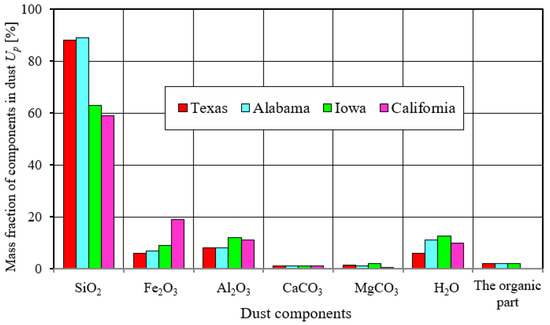
Figure 1.
Chemical composition of selected dusts from U.S. substrates. Figure made by author based on data from paper [11].
Mineral dust grains are very irregularly shaped lumps with sharp edges and are characterized by high hardness. On the 10-grade Mohs scale, where 10 corresponds to the hardness of diamond, silica has a hardness of 7 and corundum has a hardness of 9. Mineral dust has strong abrasive properties. When it enters the engine cylinders together with the air, it is the most frequent cause of accelerated wear of two frictionally mating parts, such as the P-PR-C (piston—piston rings—cylinder wall) mating parts of an engine. Dust that is drawn in with the air enters above the piston and causes the most wear on the upper part of the cylinder and piston as well as the upper piston rings. The abrasive wear of engine components is caused mainly by particles of 1–40 µm, with dust grains of 1–20 µm being the most dangerous [9,11,12,13]. The authors of [8] state that about 30% of the pollutants entering the engine may escape from the cylinders to the exhaust system unchanged together with the exhaust gases, thus increasing the emission of particulate matter (PM) from the engine. Only 10–20% of the dust that enters the engine with the air through the intake system settles on the cylinder liner walls. This part of the dust settles on the cylinder liner, where it forms a kind of abrasive paste together with the oil, which causes abrasive wear when it comes into contact with the surfaces of engine combinations, for example the piston-ring-cylinder (P-PR-C) combination.
The air filter is responsible for supplying air of sufficient quality (purity) to the engine cylinders to minimize wear on engine components. For filtration of inlet air of modern passenger car engines, due to low values of dust concentration in the air (Table 1), single-stage filters with a panel insert made mainly of pleated filter paper, which is characterized by the mass of dust retained per unit filtration area, are used. This property is determined by the dust absorption coefficient km of the filter material, which is defined as the quotient of the total dust mass mcw retained by the filter insert until the value of the permissible resistance Δpfdop is reached and the active area of the filter insert paper Ac.
For typical cellulose-based filter materials and standard dusts whose grain size does not usually exceed 100 µm, the dust absorption coefficient reaches a value in the range km = 200–250 g/m2 [14,15].
Fibrous filter baffles, as a result of dust accumulation, increase the pressure drop during operation, which causes a decrease in engine power. When the paper absorption capacity is used up, the filter cartridges must be changed periodically, the more often the vehicle is used in higher concentrations of dust in the air. Therefore trucks, working machines and military vehicles (mainly tanks, infantry fighting vehicles and armored personnel carriers), which are used in conditions of high dust concentration in the air (Table 1), are equipped with two-stage filters [16,17,18]. The first stage of filtration is then an inertia filter, a multicyclone or a monocyclone with a swirl guide, and the second stage is a porous baffle arranged in series in the form of a cylindrical insert made of pleated filter paper with a suitably selected surface area. The multicyclone used in engine inlet air filtration technology is a set of several dozens of identical return or through cyclones arranged side by side whose internal diameter does not exceed D = 40 mm [19,20,21].
The concentration of dust in the air around a moving vehicle is a variable quantity and depends mainly on the type and condition of the ground, precipitation, wind direction, conditions of vehicle movement (speed, single vehicle or column) and the type of running gear (wheeled or tracked). Therefore, the concentration of dust around a moving vehicle assumes very different values, as seen in Table 1.

Table 1.
Particulate matter concentrations in the air for different vehicle operating conditions.
Table 1.
Particulate matter concentrations in the air for different vehicle operating conditions.
| Author | Ambient Conditions | Value [g/m3] |
|---|---|---|
| [1,2] | Clean rural environments | from 0.01 mg/m3 |
| Movement of a column of tracked vehicles in desert conditions | about 20 | |
| [3] | Dusty environments | 0.001–10 |
| [22] | On highways | 0.0004–0.1 |
| [22] | When driving a column of vehicles on sandy terrain | up to 0.03–8 |
| [23] | During takeoff or landing of a helicopter on an adventure landing site at helicopter propeller tip height—0.5 m above ground | 3.33 |
| [24] | Limited visibility | 0.6–0.7 |
| Zero visibility | about 1.5 | |
| [4] | At a distance of several meters behind a column traveling at 30 km/h: | |
| 1.17 | |
| 0.62 | |
| 0.18 | |
| [5] | A tracked vehicle driving on sandy terrain at 18 km/h: | |
| 2.1–3.8 | |
| 0.8–1 | |
| [11] | A few meters away from the sand road on which the terrain vehicles were moving | 0.05–10 |
| [1,3,11] | At the inlet to the combustion engine intake system of a vehicle | not more than 2.5 |
Other sources of pollutant emissions also influence the concentration of pollutants in the air, including road transport emitting particles from tire wear [25], heating systems and thermal power plants emitting particulates and toxic gases [26], cement industry [27], field work (plowing, harvesting), biomass transport [28] and open pit coal mines emitting dust and gases [29].
The idea of using two-stage air filters is to initially separate large masses of dust from the polluted air in the multicyclone, without increasing the pressure drop, but with not very high efficiency (87–95%) and accuracy (dp > 15–35 µm), as seen in Figure 2. The remaining small mass of dust is then directed to the filter cartridge made of pleated paper, where the dust grains are retained with high efficiency (above 99.5%) and accuracy (above dp = 2–5 µm) [30,31,32]. As a result, air of the required purity is supplied to the engine cylinders and the operation time of the filtration system is extended, and thus the service interval is extended, which is limited by reaching a certain value of the pressure drop—the permissible resistance Δpfdop.
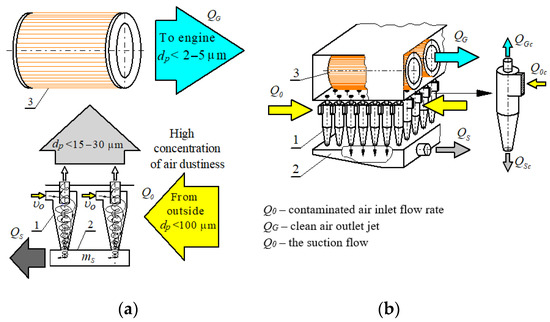
Figure 2.
Two-stage (multicyclone, filter bed) filtration system for the inlet air of an off-road vehicle engine: (a) essence of the two-stage filtration system; (b) functional diagram of the two-stage filter, 1—multicyclone (first filtration stage), 2—dust settler and 3—paper filter bed (second filtration stage).
Multicyclones can be constructed of tangential inlet or axial inlet return cyclones or pass-through cyclones. Because of their simple and robust design, lack of moving parts, high operational safety and stable and low pressure drops, as well as their comparatively low investment and operating costs, cyclones have been a very efficient and popular device for separating solids from the air stream for over 100 years. In addition, cyclones can operate under extreme conditions, including large gas flow volumes and high solids concentrations, temperatures and pressures, which is their advantage over other solid-to-gas separation technologies. Since the appearance of the first industrial cyclone in 1886, the cyclone has been widely used in aerosol filtration processes in the chemical, coal, petroleum, metallurgical, power generation and other industries [33].
A cyclone works by making the gas stream rotate so that the particles acquire centrifugal force. The rotational movement of the gas stream can be achieved either tangentially into the cylindrical part (Figure 3a–c) or axially (Figure 3d) by flowing through stationary blades with a helical outline (swirler) at the inlet of the cylindrical part.
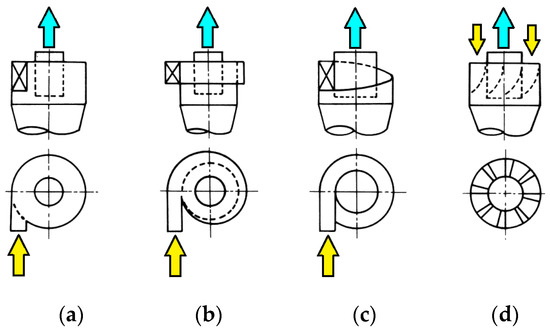
Figure 3.
Methods of gas supply to the cylindrical part of a return cyclone with inlet: (a–c) tangential, (d) axial. Figure made by the author based on data from the work [34].
Due to the principle of operation, cyclones can be divided into reverse, when the aerosol changes the direction of flow by 180° (Figure 4a,b), clean gas and collected particles leave the device on opposite sides and through, when the aerosol does not change the direction of flow, and then the gas and particles pass through the cyclone in one direction only, leaving from the same end of the device (Figure 4c).
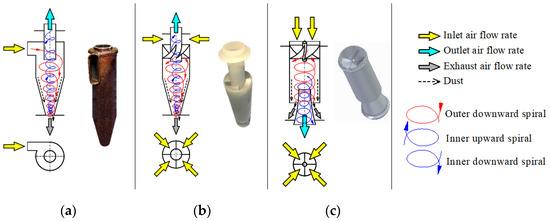
Figure 4.
Types of cyclones used for filtering the intake air in motor vehicles: (a) reverse-flow cyclone, (b) return with axial inlet and (c) axial flow (vortex tube separators).
A conventional tangential inlet reciprocating cyclone comprises a cylindrical part, which then tapers downward in the form of a cone terminated by a discharge opening and a dust collector. A tangential inlet is attached to the cylindrical part of the cyclone, which causes the gas containing the dust to swirl, resulting in a spiral motion that first descends along the outer spiral, then ascends through the inner spiral and finally leaves the cyclone through the outlet pipe at the top of the cyclone (Figure 4a). The centrifugal force created by the swirling motion causes the higher mass particulates in the gas to move (overcoming the drag force of the air) toward the outer wall of the cyclone, where they are braked and stopped, and then fall by gravity into the dust container. Gas flowing spirally downwards, due to the shrinking diameter of the circular cone and the attraction of the low-pressure zone in the middle of the cyclone, changes its direction of movement spirally upwards at the bottom of the cone. The gas purified from larger dust grains is discharged from the cyclone through a cylindrical outlet tube located in the upper part of the cyclone. The cylindrical part of the cyclone is connected to the outlet pipe by a tight cover. The cyclone design is simple, but the gas flow inside is a complex three-dimensional vortex flow [35].
Cyclones differ in construction, principle of operation and separation efficiency, which is described by the characteristics of separation efficiency and pressure drop. Examples of characteristics of cyclones, which are elements of air filters of off-road vehicles, are shown in Figure 5. The diagrams show a close relation between the separation efficiency and pressure drop of the cyclone, indicating that the greater the filtration efficiency, the greater the value of the pressure drop and vice versa. A high value of filter pressure drop adversely affects engine operation, causing a decrease in engine cylinder filling and effective power, hence the desire to reduce them. High separation efficiency is important to minimize wear and tear on engine components, which increases engine durability and vehicle mileage. Air filter performance is a technical compromise between its pressure drop, separation efficiency and accuracy, as well as engine wear and durability and vehicle reliability [1,2,3,7,13].
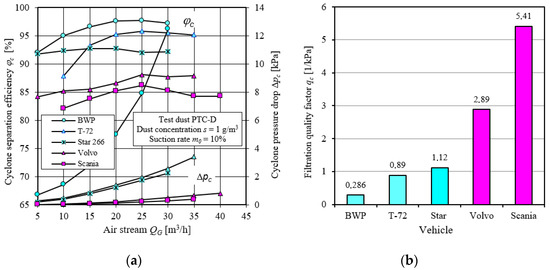
Figure 5.
Filtration properties of cyclones as elements of off-road vehicle air filters: (a) characteristics of separation efficiency φc = f(QG) and pressure drop Δpc = f(QG); (b) filtration quality factor.
At the maximum value of the air stream QG = 30 m3/h, the tangential inlet reversible cyclone BWP reaches a pressure drop of the order of 12 kPa, exceeding by several times the pressure drop of the tangential inlet cyclones. At a slightly higher value of air stream QG = 35 m3/h, the pressure drop of another tangential inlet reverse cyclone T-72 reaches the value of 3.4 kPa. The filtration efficiencies of the tangential inlet return cyclones take the values 96.9% and 95.6%, respectively. Scania and Volvo tangential inlet backflow cyclones have much lower pressure drop values at 0.36 kPa and 0.58 kPa, and much lower values of filtration efficiency at 87.7% and 85.2%, respectively [36].
A comparison between cyclones of different filtration properties can be made with the use of the conventional filtration quality factor qc, which relates the separation efficiency and pressure drop with the following relation the quality factor [37]:
where φ0 is the cyclone filtration efficiency (–) and ∆p is the pressure drop for nominal air stream (kPa).
The higher the value of the qc coefficient, the more favorable the cyclone efficiency. It should be noted that the filtration quality factor qc defined in this way optimizes the cyclone only due to separation efficiency and pressure drop. The qc coefficient does not take into account the filtration accuracy of the cyclone, which clearly increases as the air velocity through the cyclone increases, just as the pressure drop increases.
The values of filtration quality coefficients of cyclones, whose characteristics are shown in Figure 4a, are shown in Figure 4b. The pass-through cyclones take values of the filtration quality factor q several times higher than the tangential inlet return cyclones.
The continuous pursuit to increase the durability of truck and special vehicle engines, which are operated in conditions of high values of dust concentrations in the air, sets more and more stringent requirements for two-stage air filters in terms of separation efficiency and accuracy, as well as pressure drop. For this reason, it is reasonable to take measures to use return cyclones, which are characterized by high values of filtration efficiency, for the filtration of inlet air in these vehicles. This will reduce the mass of dust directed to the second filtration stage, thereby extending the vehicle’s service interval. However, due to the high pressure drop, measures are needed to reduce it, which will minimize the decrease in engine power.
High cyclone operating efficiency, determined by separation efficiency and pressure drop p, is obtained by using appropriate air flow velocities and proportions of its main dimensions, also called geometrical parameters or dimensionless numbers. For tangential inlet reciprocating cyclones, such proportions in the form of quotients of the main dimensions have been established as a result of research work conducted over a number of years [38,39,40,41,42,43,44,45,46,47,48,49,50,51,52,53,54].
These research works have shown a mutual dependence between the main dimensions of a cyclone and have led to the determination of such proportions of these dimensions (quotients of main dimensions), for which a cyclone obtains optimal working conditions in the scope of the maximum separation efficiency and minimum pressure drop. The main dimensions of a tangential inlet return cyclone are shown in Figure 6.
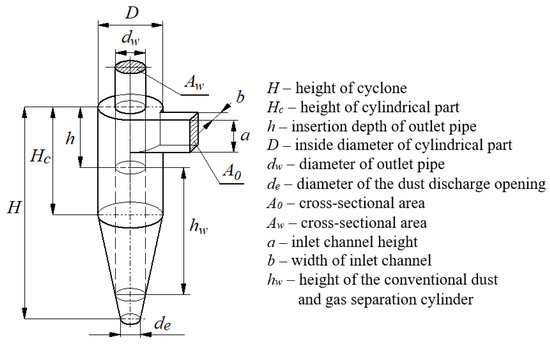
Figure 6.
Characteristic dimensions of a tangential inlet return cyclone.
For example, the author of [55] combined the variables determining the cyclone separation efficiency (cyclone main dimensions, air and dust flow parameters) and presented the cyclone efficiency as a function:
The quotients dw/D to de/D are dimensionless numbers for the cyclone configuration, Re and Fr are dimensionless numbers for the gas flow, called Reynolds number and Froude number and can be defined as follows, respectively:
Stk is a dimensionless number that determines particle dynamics, which is called the Stokes number and can be defined as follows:
Den is a density number that can be defined as the quotient of the gas density ρg and the dust density ρp:
From the presented (Figure 7) example changes of separation efficiency c and pressure drop coefficient c as a function of the quotient Aw/A0 and H/dw, it can be seen that the optimal range of these parameters is in the range of 1.5–2 and 7–9, respectively [39,40]. The use of these data during the design work of cyclones makes it possible to obtain a relatively high separation efficiency of the inlet air to internal combustion engines with respect to micron particles. Any arbitrary change in one of the cyclone dimensions can cause the opposite effect.
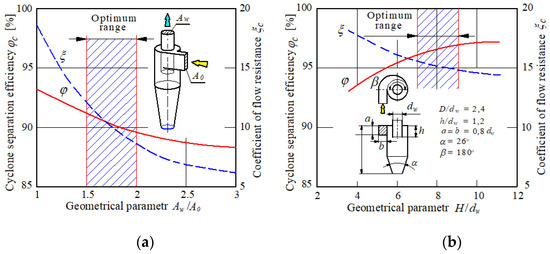
Figure 7.
Separation efficiency φc and coefficient of pressure drop ξc of cyclones as a function of: (a) Aw/A0 and (b) H/dw parameter. Figure made by author based on data from paper [39].
The pressure drop coefficient c is defined by the relation:
where ρg is the gas density, Δpc is the air pressure drop through the cyclone and υ0 is the outlet velocity from the cyclone.
The gas velocity in the cyclone is represented by the average velocity at the inlet port (inlet velocity) υ0, which is defined by the relation:
where Q0 is the flow of air entering the cyclone and A0 is the cross-sectional area of the inlet spigot at its narrowest point.
The range of inlet velocities 0, within the limits of which the changes in the purification efficiency are relatively small, should be as large as possible because it makes it possible to use the best separating capabilities of the cyclone at a widely varying air stream QG as a result of changes in the engine rotational speed n. The range of inlet velocities 0 is at the level of υ0 = 12–20 m/s, and exceptionally reaches the value of 25 m/s [56,57,58,59]. The use of high velocities generates high pressure drop. According to the study of the author of [60], the cyclone inlet velocity reaches υ0 = 35 m/s, but the pressure drop also reaches a large (about 4 kPa) value.
Therefore, work is constantly conducted to increase the efficiency of aerosol particle separation in cyclones and to reduce their pressure drop. This goal is achieved by modifying the cyclone design but keeping the cyclone’s main dimension quotients. The available literature describes various ways to improve the efficiency of cyclones of different diameters over a wide range. Each cyclone is designed to perform a specific task and is associated with unique flow physics, which is strongly influenced by its geometry.
This paper aims to analysis the available design solutions of tangential inlet return cyclones in terms of their applicability to modify a return cyclone with a cylindrical part diameter of 40 mm, which is a component of an off-road vehicle air filter multicyclone. Proposed and performed modifications of cyclones will be verified during experimental tests on a laboratory bench.
2. Analysis of Options for Increasing the Separation Efficiency of Tangential Inlet Return Cyclones
Ongoing research on tangential inlet return cyclones is aimed at improving their performance by increasing the efficiency of aerosol particle separation in cyclones and reducing air pressure drop. This effect can be achieved by modifying the cyclone design, but without interfering with its basic geometric dimensions. To date, many such experimental and numerical studies of tangential inlet return cyclones have been conducted, where the researchers have focused on the individual effects that a single geometric factor has on the separation efficiency and pressure drop of the cyclone. The studies included modification of three cyclone components:
- (1)
- The cyclone inlet (shaping the inlet tube or changing the way the inlet stream is fed into the cylindrical part of the cyclone) [61,62,63,64,65,66,67,68,69,70,71,72,73,74,75,76,77,78,79];
- (2)
- The cyclone outlet tube (shaping the outlet tube and using special steering wheels (deswirlers) inside the outlet tube) [80,81,82,83,84,85,86];
- (3)
- The dumping hole and dust container [87,88,89,90,91,92,93,94].
In tangential inlet return cyclones, a single symmetrical inlet with rounded edges in the form of a tube with a rectangular cross-section with sides a and b is commonly used (Figure 1), with the longer side a aligned parallel to the cyclone’s main axis. It has been found that the optimal ratio of inlet width to inlet height b/a is in the range of 0.25–0.5 [53,54], although the authors of [59] report a different range from 0.5 to 0.7
Therefore, a lot of work has been undertaken on the organization of the aerosol inlet into the cyclone. The authors of the work [51,52,53,54,55,56,57,58,59,60,61,62,63,64] believe that replacing one inlet channel with several inlet channels will improve the cyclone efficiency. Reference [61] presents a comparative analysis of the original cyclone (one inlet channel) with the designs of two cyclones that are equipped with four equal inlet channels. In cyclone one, the inlet channels were set symmetrically around the circumference of the cylindrical part (every 90°) at the same level as the inlet channel in the original cyclone. In cyclone two, the inlet channels were set symmetrically and arranged as stairs along the axial direction of the cyclone. The total inlet area of the four channels in the new designs remained the same. Therefore, the height and width of the inlet channel in the two new designs are equal to half the height and width of the inlet channel in the original cyclone. The cyclone design with four inlets achieved, in the inlet velocity range of 10–25 m/s, better filtration performance than the original cyclone.
In Reference [62], a numerical study of cyclones of new design with one, two and three tangential inlet channels symmetrically arranged in the cylindrical part at the same level was carried out. This cyclone differs from the conventional cyclone in the separation space. Instead of the conical part of the cyclone, a cylindrical part and a vortex limiter were used. The inlet channels have the same design. It was found that the cyclone with three inlets has higher separation efficiency and lower pressure drop, which is beneficial to cyclone performance. The cyclone with three inlets has a more favorable distribution of turbulent kinetic energy compared to cyclones with one and two inlets, which may lead to less noise in the cyclones and their pipelines.
Numerical results of cyclones of a new design with one, two and three tangential inlet channels symmetrically arranged in the cylindrical part at the same level are presented in [63]. The total inlet area of two and three channels in the new designs remained the same. The results show that the modification proposed in this paper increases the separation efficiency of particles smaller than 3 μm to 50% and particles larger than 6 μm to 15% compared to the conventional design. Increasing the inlet velocity from 14 to 20 m/s increases the separation efficiency for all particle sizes, but is associated with a significant increase (doubling) of the pressure drop. The proposed modification simultaneously reduces the erosion rate by 54%.
The object of study of the authors of [64] was a cyclone with two inlet channels (main and auxiliary), where the auxiliary inlet channel with a square cross-section was much smaller than the main channel. The inlet channels were rotated 180° with respect to each other. Tests were conducted for three variables: the flow rate through the secondary inlet channel, the cross-sectional area of the secondary channel and the position of the top of the main inlet channel relative to the cyclone lid. The optimum design obtained from the tests provides better performance than conventional cyclones.
El-Emam et al. [65] fabricated and optimized the geometry of a tangential inlet return cyclone by varying the position and dimensions of the inlet channel and the length of the cylindrical part of the cyclone at a constant air inlet velocity of υ0 = 30 m/s. Five cyclones with different sizes and dimensional proportions of the inlet channels and the position of the inlet relative to the cyclone top cover, were modeled computationally. The inlet channel width and the diameter of the cylindrical inlet channel were assumed constant. It was shown that cyclone modification (III), in which the inlet channel has twice the height of the original cyclone, provided the highest (98.6%) filtration efficiency. Increasing or decreasing the height of the inlet channel more than in cyclone (III) has a negative effect on cyclone performance. Additionally, decreasing the length of the cylindrical part and changing the original position of the cyclone inlet channel gives poor cyclone performance.
In the work [66], a tangential inlet reciprocating cyclone (without cylindrical part) with two equal symmetrical inlets attached to the conical section at the top of the section was numerically investigated. In contrast, Lim et al. [67] installed additional inlets in the conical section of a tangential cyclone separator, numerically investigated and then experimentally verified their effect on filtration efficiency and pressure drop. When aerosol was metered through the additional inlet channels and clean air was fed into the original inlet channel, the boundary grain diameter decreased compared to when aerosol was metered only through the original inlet channel. It is shown that there is an optimum flow rate through the additional inlet ducts that increases the separation efficiency of the cyclone. Dosing the aerosol simultaneously through the additional inlet channels and through the original inlet channel resulted in a larger aerosol stream being filtered, while showing similar levels of efficiency and pressure drop compared to the original cyclone.
Wang et al. [68] studied the effect of the inlet channel angle of a feedback cyclone on its filtration efficiency. The angular inclination (−30°, −15°, 0°), the downward inlet channel with respect to the horizontal and the upward channel angular inclination (0°, 15°, 30°) were analyzed. It is shown that the inlet channel inclination angle has a direct effect on the gas introduction direction, resulting in changes in pressure drop and filtration efficiency.
The pressure drop initially decreases, reaches a minimum value at an inlet angle of 0°, and then increases as the inlet angle increases (Figure 8). A negative inlet angle results in a greater pressure drop compared to a positive inlet angle of the same value.
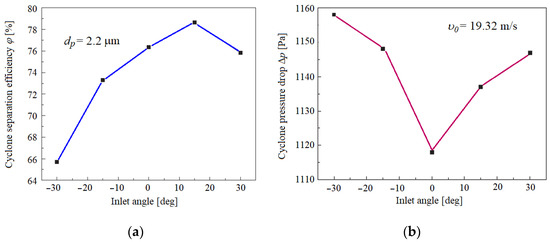
Figure 8.
Effect of inlet channel angle of the return cyclone on: (a) filtration efficiency and (b) cyclone pressure drop. Figure made by the author based on data from paper [68].
The separation efficiency first increases, reaches a maximum value at an inlet (channel) angle of 15° and then decreases as the inlet angle changes from negative to positive. High agreement was obtained between the numerical simulation results and the experimental results.
A similar problem was addressed by the authors of [69], who studied the effect of changing the inlet channel angle contained in the vertical plane α and additionally in the horizontal plane β (Figure 9) on the changes in pressure drop and filtration efficiency. The lowest static pressure was recorded in the basic model, and for the other models, the value increased with the increasing channel angle on both sides.
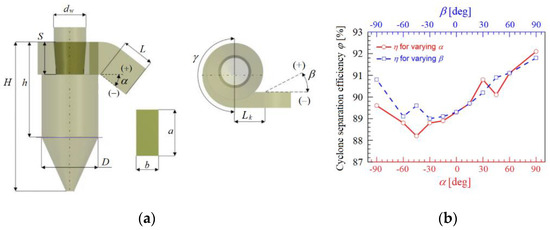
Figure 9.
Effect of changing the angle of the cyclone inlet channel: (a) cyclone inlet channel angle in vertical plane α and horizontal plane β; (b) effect of angles α and β on filtration efficiency. Figure made by the author based on data from the paper [69].
For changes in angle in the vertical plane α, feeding the solids from the top (angle α positive) provided higher values of separation efficiency due to better penetration of both phases into the lower areas of the cyclone. The separation efficiency increased with increasing angle (except for angle α = 45°), with the cyclone reaching its maximum value for channel angle α = 90° (Figure 9). There was a 3.1% increase in the separation efficiency of the cyclone compared to the angle α = 0°. For changes in channel inclination angles in the horizontal plane, angles greater than 0° are preferable. This allowed for a larger particulate stream to be directed towards the cyclone walls, thus providing better particulate penetration in that direction. The maximum value of separation efficiency was achieved by the cyclone for the angle of channel inclination β = 90°—an increase in efficiency by 2.8% compared to angle β = 0°.
Yoshida et al. [70] applied an additional tangential inlet to a reversible cyclone with a diameter of D = 72 mm, by means of which they metered a stream of clean compressed air in the range of q = 0–210 dm3/min, maintaining the following condition: QG + q = const = 630 dm3/min. Changing the position of the additional inlet tangent along the height of the cylindrical part, the highest separation efficiency of the cyclone was obtained when both inlet tangents were located in the same plane in the upper cylindrical part of the cyclone, and their symmetry axes were parallel, angle = 180°, as shown in Figure 10. An increase in the flow of additional air in the range q = 0–210 dm3/min caused an increase in separation efficiency of the cyclone from φc = 93.2% to φc = 98.1%.
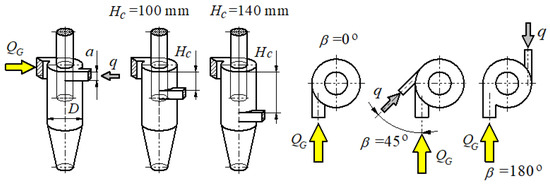
Figure 10.
Reverse flow cyclone with a tangential inlet with additional inlet port in its cylindrical section. Figure made by the author based on data from paper [70].
Misiulia et al. [71] conducted a numerical study of a spiral inlet return cyclone with an inner diameter of the cylindrical part D = 0.24 m for five different inlet angles (α = 7°, 11°, 15°, 20° and 25°). The height of the spiral cyclone inlet channel depends directly on the inlet angle α and takes on increasing values as α increases. High separation efficiency with moderate pressure drop was obtained for an optimal inlet angle in the range of 10–15°. The same authors in another paper [72] extended the study of the same cyclone. They analyzed numerically five cyclone models with spiral inlet channels with different angles (α = 7°, 11°, 15°, 20° and 25°) and five cyclone models with tangential inlet channels with different inlet heights at the same other geometrical dimensions. Cyclones with spiral inlet have higher separation efficiency compared to cyclones with tangential inlet. The highest separation efficiency was achieved at an inlet angle of 20°. The pressure drop decreases significantly as the inlet angle increases.
The subjects of the authors’ experimental study [73] were two conventional cyclones A and B with a single inlet and cyclone C with double inlet. Models A and B are single-suction cyclones with different inlet channel width b and outlet tube diameters, but all other dimensions are the same. Model C, a double inlet cyclone, has the same dimensions as model A except the inlet duct is divided into two equal parts. Air containing particulate matter was introduced into the outer part of the inlet duct. Clean air was introduced into the inlet near the cyclone wall. The effectiveness of the double inlet cyclone was evaluated at different flow rates of clean air, keeping the flow rate of particulate containing air constant. The filtration efficiency of the double inlet cyclone was found to be 5–15% higher and the pressure drop more than 35% lower than that of the single inlet cyclone at the same inlet size and outlet tube diameter. As the clean air flow rate increases, the cyclone filtration efficiency increases.
Similarly, Zhao et al. [74] conducted an experimental study of three tangential inlet return cyclone models with an inner diameter of the cylindrical part D = 300 mm. A conventional cyclone A with a single inlet channel and two cyclones B and C with two inlet channels strapped on the cylindrical part and spaced 180° apart at the same level were studied. The inlet channels of cyclone C have the same dimensions (a and b) as the channel of cyclone A. The inlet channels of cyclone B have their width halved (b/2). Experimental tests at a concentration of 5 g/m3 showed that cyclone C obtains, over the entire range of inlet velocity υ0 = 11.99–23.85 m/s, the highest values of filtration efficiency and the lowest values of grain limit d50.
Bernardo et al. [75] used a three-dimensional computational fluid dynamics (CFD) model to describe the flow of gas and solids in a cyclone with a spiral inlet channel at three different inlet angles (α = 30°, 45° and 60°) relative to the cyclone body. Numerical results show that the filtration efficiency value in this work increased to 77.2% for the inlet channel inclination angle α = 45°, while the efficiency value for the standard inlet channel was 54.4% under the same operating conditions.
The effect of periodic inlet velocity on the performance of standard tangential inlet return cyclones was presented [76]. Four cyclone models with the same inner diameter of the cylindrical part but differing in the height a and width b of the inlet channel, the height of the cylindrical and conical parts, the diameter of the outlet tube and the diameter of the dust discharge opening were numerically studied and experimentally verified. The same value of inlet velocity was assumed. The inlet velocity in the duct and the air particle velocity were described by a sinusoidal trigonometric function.
In [77], the flow field in tangential inlet return cyclones with a cylindrical part diameter D = 300 mm was simulated with different diameters (95, 108, 115, 120, 135, 140 and 150 mm) of the outlet tube and dimensions (Ka = 5.5, 7.5 and 9.8) of the inlet channel described on the cylindrical part (180°) using the Reynolds stress model to determine the axial velocity stagnation mechanism. The dimensionless parameter Ka defines the ratio of the cross-sectional area of the cylinder of diameter D to the cross-sectional area of the inlet channel with rectangular sides a and b.
Numerical studies of the effect of inlet channel length on the flow field and filtration efficiency of a return cyclone with an asymmetrical tangential inlet and their experimental verification are presented in [78]. The inlet channel length was varied in the range Li = 0.75D–3D while keeping the height b and width a1 at the channel inlet constant. Changing the length of the inlet channel caused the angle of the inlet channel contained in the horizontal plane to decrease (Figure 11).
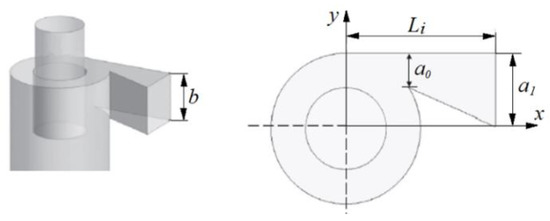
Figure 11.
Geometry of the inlet channel of the return cyclone. Figure made by the author based on data from work [78].
Simulation results showed that increasing the length Li of the inlet channel led to an increase in the tangential velocity of the gas in the cyclone body. An increase in inlet channel length resulted in a decrease in pressure drop and filtration efficiency, particularly evident in the range up to Li = 1.5D. Above this value, the effect of inlet channel length on both the pressure drop and filtration efficiency is small. The trend of pressure drop was similar to the trend of gas tangential velocity decrease with increasing Li.
Dzierżanowski et al. [79] demonstrated that the symmetrical inlet, which is commonly used, causes unfavorable mass distribution of dust particles in the cross-section (Figure 12a), which may have a negative effect on separation efficiency. The replacement of the symmetrical inlet with an asymmetrical inlet (Figure 12b), or the use of “K” vanes immediately before such an inlet (Figure 12c), causes a significant mass of dust to be directed (already at the inlet) towards the outer wall of the cylindrical part of the cyclone, which naturally facilitates its separation from the air and thus increases separation efficiency.
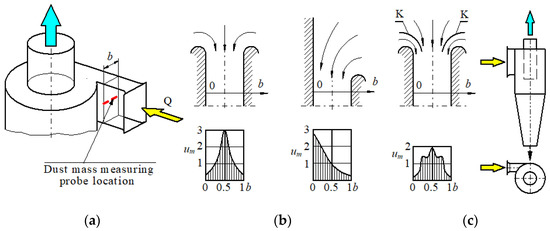
Figure 12.
Cross-sectional dust particle size distribution—flat inlet: (a) symmetrical, (b) asymmetrical and (c) symmetrical with guide vanes um—relative dust fraction in the inlet air stream [79].
From the presented analysis, it can be seen that the organization of the aerosol inlet into the cyclone is being addressed by many researchers. The ongoing work is directed towards the use of a larger number (up to four) of inlet channels arranged symmetrically in the cylindrical part at the same level or shifted with respect to each other towards the conical part. Channels of the same or changed shape and cross-sectional area are used. It is proposed to construct cyclones with a different angle of inclination of the inlet channel in the vertical and horizontal plane. Numerical and experimental tests of modified cyclone constructions showed an increase in separation efficiency and a decrease in pressure drop, which confirms the purposefulness of conducting such tests.
All previous studies show that the largest share, estimated at 75–90%, of the total gas pressure losses in the cyclone are the losses incurred during flow through the cyclone inner tube (outlet tube) [40]. The pressure losses are a result of the resistance at the inlet to the outlet tube and the friction resistance during the gas flow through the tube. In addition, gas flows through the outlet tube and makes a helical motion towards the cyclone outlet. Hence, there have been numerous searches for ways to reduce these losses, primarily by giving the outlet tube more favorable shapes (conical) and giving streamlined shapes to the edges of the inlet opening, installing internal vanes and adding reversible heads to convert the kinetic energy of spiral motion of the gas inside the outlet tube into pressure energy and the kinetic energy of linear motion [80,81,82,83,84,85,86].
Lim et al. [80] performed an experimental analysis of the effect of the outlet tube shape on the separation efficiency and pressure drop. The experiments were performed for two air flow rates (30 dm3/min and 50 dm3/min) of four cyclone models with cylindrical outlet tubes with diameters of 15, 11 and 7 mm and six cyclone models with cone-shaped outlet tubes. The cone-shaped tubes had different cone lengths (10, 25 and 45 mm), with diameters of 7 and 15 mm at both ends of the cone (Figure 13). The pressure drop and separation efficiency of the conical tubes were greater than that of the 15 mm diameter cylindrical tube and less than that of the 7 mm diameter cylindrical tube. In addition, the pressure drop per unit flow rate (Δp/Q) for the cone-shaped outlet tube design (7-B, 7-C and 7-D) is less compared to the cylindrical-shaped design (7-A).

Figure 13.
Geometry and dimensions of the cyclone outlet tube. Drawing made by author based on data from work [80].
The study presented in [81] aimed to obtain detailed flow information using CFD simulations in cyclones tested previously by Lim et al. [80]. Figure 14 shows the pressure contours at a flow rate of 70/min in a cyclone with different outlet tube inlet shapes. By decreasing the divergence angle of the outlet tube, the low-pressure zone in the center of the cyclones expands. More particles are trapped in this zone and transported to the cyclone outlet. Thus, the efficiency of the cyclone is lower.
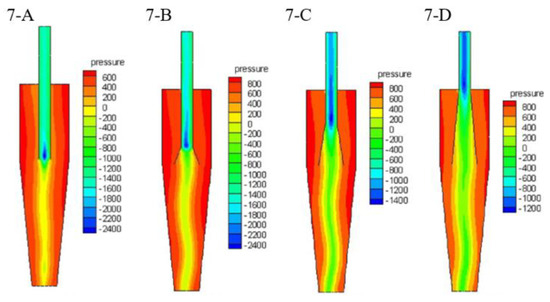
Figure 14.
Pressure contours (Pa) at a flow rate of 70/min in the cyclone. Figure made by author based on data from paper [81].
Another way to reduce the pressure drop of the cyclone is to use special guides (deswirlers) inside the outlet tube to convert the kinetic energy of spiral motion, which the gas stream moves inside the outlet tube, into kinetic energy of linear motion.
Misiulia et al. [82] presented the results of optimizing the geometry of a deswirler located in the outlet tube of a feedback cyclone with a spiral inlet channel (Figure 15) using the pressure drop of the cyclone as a criterion. For this purpose, 70 different configurations of the deswirler (also known as the unscrewing or straightening device) were investigated, which were obtained by varying the range of its geometrical parameters: dc/Dv = 0.4–0.8; n = 1–9; h/Dv = 0.4–2; α = 10–50°. The optimization results indicated that the most significant geometric parameters of the deswirer are the number of blades, blade angle and blade height. It was shown that the new optimized deswirler significantly (by about 56%) reduces the static pressure on the cyclone wall and about 20% in the core. It reduces the pressure loss in the outlet tube by 95.67%, leading to a 43.17% reduction in total cyclone pressure drop. It slightly reduces the separation efficiency for some particle diameters, increasing the cyclone boundary grain diameter from 1.5 to 1.72 µm.
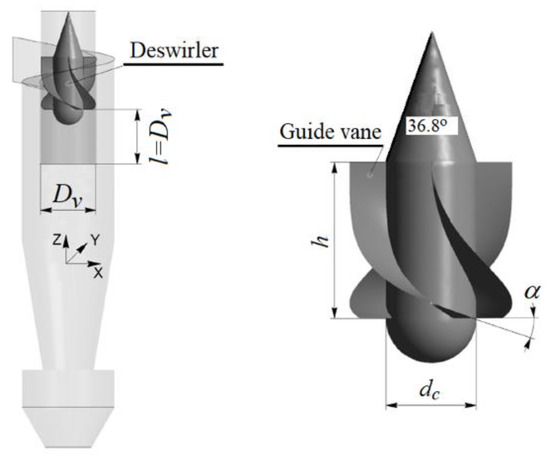
Figure 15.
Deswirler geometry and dimensions: Dv—vortex finder diameter, l—mounting height in the vortex finder, dc—deswirler core diameter, h—height of guide vanes and α—leading edge angle. Figure made by author based on data from paper [82].
In [83], based on the analysis of available flow straightening (unstraining) devices, a new design of flow straightening device using vanes was proposed, which reduces the energy consumption of the most commonly used cyclones by 25–29%, respectively, without compromising the separation efficiency. Figure 16 shows the components (proposed by LG Electronics) mounted on the inlet of the outlet tube, which reduce the pressure loss in the cyclone.

Figure 16.
Devices proposed by LG Electronics to reduce pressure loss in cyclones. Figure made by author based on data from paper [83].
Figure 17 shows the components used to straighten the flow inside the outlet tube by Samsung Gwangju Electronics Co. [83], resulting in a reduction of pressure loss. From Figure 17, it can be seen that the pressure loss in the cyclone is reduced mainly by using the F-type rectifying element. Using it in the cyclone outlet tube reduced the power loss by about 11% [8].
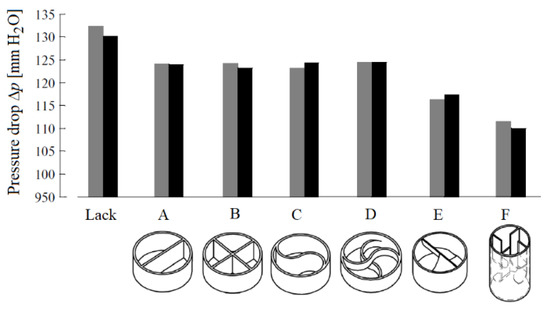
Figure 17.
Pressure drop values for individual components used to straighten the flow inside the cyclone outlet tube of Samsung Gwangju Electronics Co. Figure made by author based on data from paper [83].
Reference [84] presents a numerical and experimental study of four reciprocating cyclone models with tangential inlet. In the three cyclone models, oblique (at an angle of α = 45°) bevels (notches) were made at the inlet of the outlet tube, which were deviated from the cyclone inlet by the following angles: α = 45°, 135° and 225°. The simulation results show that the separation efficiency of the cyclones that used outlet tubes with notched cutoffs increased significantly compared to the separation efficiency of the original cyclone. The largest increase in efficiency was obtained for the cyclone in which the bevel of the outlet tube was deflected from the cyclone inlet by an angle α = 225. The experimental results show that this cyclone model can remove particles with a diameter greater than 3.5 μm, while the original cyclone can only remove particles with a diameter greater than 3.5 μm. The separation efficiency of the original cyclone is 73% and that of the cyclone with the modified outlet tube is 76%.
Wang et al. [85] conducted an experimental study of two cyclone models with single and double inlet duct and with cylindrical and inverted cone outlet tube. The cyclone with cylindrical outlet tube has higher separation efficiency and pressure drop for both single and dual inlet channel cyclone. For dual inlet cyclones, the smaller the diameter of the outlet tube (cylindrical or inverted cone), the higher the separation efficiency and pressure drop.
The author of [40] presented the possibilities of modifying the outlet tube in a tangential inlet return cyclone, which can reduce the pressure drop (Figure 18).
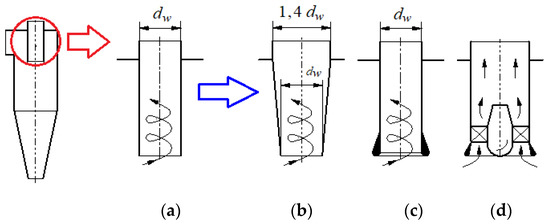
Figure 18.
Available shapes of an inner cyclone tube: (a) cylindrical tube—standard, (b) conical tube, (c) cylindrical tube with streamlined inlet port and (d) tube with guide vanes. Figure made by author based on data from paper [40].
The analysis presented here shows that there are a number of design options for modifying the outlet tube to reduce the flow resistance through this element. Replacing the traditional cylindrical outlet tube with a conical one. and introducing a streamlined shape of the inlet opening of the outlet tube. can significantly reduce the flow resistance of the cyclone without causing a decrease in filtration efficiency. The gas stream flowing out of the cyclone through the outlet tube still performs an upward helical motion, resulting in pressure losses. These losses depend on the geometry of the cyclone and can be up to 50% of the total pressure drop in the cyclone. This remaining energy in the swirling stream can be recovered or used to increase the cyclone’s filtration efficiency by installing a special element, the deswirler (also called a de-swirler or straightening device), in the cyclone’s outlet tube. This can significantly reduce the pressure loss when flowing through the outlet tube. In the available literature, one does not encounter works analyzing the aerosol flow through the outlet tube with the streamlined shape of the inlet opening edge (Figure 18c).
In order to prevent the transfer of the gas vortex motion to the cyclone dust settling tank and lifting separated and already retained dust from it, a special container (settling tank) is attached to the dust discharge opening—dipleg [87,88,89,90,91,92,93,94,95,96]. This method is recommended for use in those cyclones, where extracting separated dust from the settling tank was not applied, and in “short” cyclones, i.e., with a small ratio of the cyclone height H to its diameter D. Problems of dust extraction from the settling tank of a multicyclone are presented in other works [97,98].
Elsayed et al. [87] studying the influence of the dimensions of the cylindrical dust settling tank (height and diameter) on the cyclone performance showed that the optimal design of the settling tank and the dipleg (an extended part of the lower part of the cyclone, connecting the cyclone with the dust settling tank) leads to better separation efficiency than a conventional cyclone. The authors of [88], using the CFD program, investigated the effect of the dipleg shape (cylindrical, inverted cone, conical and diamond) on flow characteristics and cyclone performance, as shown in Figure 19.They found that the dipleg geometry significantly affects the pressure drop of the cyclone. The cylindrical dipleg generated the highest pressure drop, while the lowest pressure drop was observed for the cyclone without dipleg. Among the geometries tested, the highest separation efficiency was found for the cyclone with a conical dipleg, while the diamond dipleg led to the lowest efficiency.
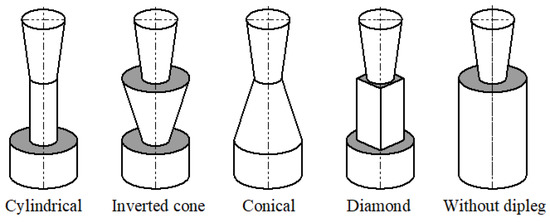
Figure 19.
Different shapes of dust reservoirs (dipleg) of cyclones. Figure made by author based on data from paper [83].
Kaya et al. [89] numerically investigated the particle filtration process inside two cyclones whose conical part was extended by a cylindrical dipleg with a diameter equal to that of the outlet opening. They found that the length of the dipleg significantly affects the cyclone separation efficiency by providing a larger separation space and minimizing the re-lift of separated particles. The calculated cyclone filtration efficiencies for different inlet velocities in the range υ0 = 7–16 m/s and for particles with diameters of 1.5 µm are shown in Figure 20a. A trend of increasing separation efficiency up to a dipleg length of Ld = 38.5 mm can be seen. However, the cyclone separation efficiency begins to decrease for inlet velocities less than 10 m/s. For higher inlet velocities, the cyclone efficiency assumes significant values that remain almost constant. The optimum dipleg length, in terms of maximum separation efficiency, is obtained with a parameter value of Ld/L = 0.5, where L is the total length of the cyclone.
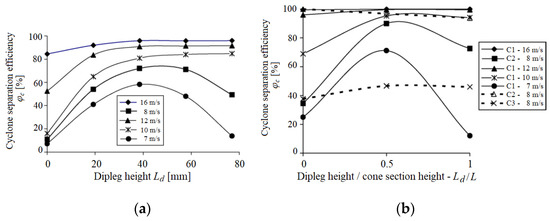
Figure 20.
Cyclone separation efficiency for different inlet velocities depending on (a) dipleg length Ld and (b) Ld/L parameter value. Figure made by the author based on data from the work [89].
In [90], the results of the separation efficiency of three cyclones with different lengths of cylindrical diplegs and with an invariant dust settling tank are presented. It was shown that the tangential velocity, axial velocity and turbulent kinetic energy in the settling tank decreased significantly when the dipleg length was extended. This means that the dipleg dust settler can effectively prevent the re-entrainment of already separated dust. In addition, the extended part of the dipleg increases the dust separation space, and thus the separation efficiency increases, at the cost of a slightly increased pressure drop.
One of the methods of increasing separation efficiency of a cyclone is mounting an additional element (cone) on the outlet of dust from the cyclone to the settling tank. The task of this element, also called an apex cone, is to limit secondary circulation of separated dust particles. It is very important to precisely select the diameter of the cone, the apex angle, and its proper location. Incorrect selection of these parameters may block the bottom outlet of the cyclone and hinder dust falling into the container, and thus reduce the cyclone separation efficiency.
Therefore, in [91], using two research methods—computational fluid dynamics (CFD) and experimental studies—the effect of 15 variants of geometric configurations of the counter cone on the cyclone efficiency was analyzed. The geometry of the counter cone was determined by the following parameters (Figure 16): Ds—diameter of the counter cone (368, 436 and 520 mm), α—tip angle (85°, 95° and 105°), Bh—distance from the base of the counter cone to the bottom outlet of the cyclone of diameter (0.1B, 0.15B and 0.35B).
It was found that the use of a counter cone in each of the geometric variants tested led to an increase in cyclone efficiency. The results show that the counter cone should be located above the bottom outlet of the cyclone (Figure 21a,c). The optimal position of the counter cone (assuming maximization of separation efficiency) can be obtained when the distance of the counter cone base from the bottom outlet is Bh = 0.15B (82.5 mm). The apex angle of the counter cone should α = 85°. An improvement in separation efficiency was observed for particles smaller than 60 µm. This is due to the fact that the phenomenon of particle re-entrainment concerns fine particles in particular, particles up to 15 µm in diameter. The use of an apex angle with a value above 100° may be associated with the risk of excessive agglomeration of particles in the counter cone area.

Figure 21.
Examples of variants of analyzed geometric configurations of the counter cone [86]. (a–c)—cones with different values of angle α at the same height Bh above the diameter of the lower (dust) outlet of the cyclone, (d–f)—cones with the same value of angle α at different heights Bh below the diameter of the lower (dust) outlet of the cyclone.
The authors of [92,93,94] studied the apex angle of the counter cone at the dust outlet of the cyclone in the range α = 40–80°. They found that the optimal value of the angle due to maximum separation efficiency is α = 70°. Furthermore, they observed that increasing the gap between the cone and the wall of the conical part of the cyclone increased the number of small particles that enter the dust container.
The author of [95] compared two suggested locations of the cone (below the cyclone outlet and in the conical part of the cyclone) using CFD. He concluded that placing the cone below the conical part of the cyclone is more beneficial as it helps to increase the particle separation efficiency.
Obermair et al. [96] experimentally studied cyclones with three different cyclone dust outlet geometries: a cyclone with a dust trap with a cone at the cyclone outlet, and a cyclone with a cylindrical dipleg. They found that in the case of a cyclone with a dust settler only, the rotating flow goes from the cyclone cone to the settler, which causes the collected particles to be entrained again. For the cyclone with an apex cone, an improvement in cyclone efficiency was achieved. Two design variants of the counter cone were analyzed. In the first variant, the counter cone (apex angle α = 90°) was located under the bottom outlet of the cyclone. In the second variant, the counter cone (α = 120°) was located above the lower cyclone outlet. The latter solution led to an increase in separation efficiency by 2% and an increase in pressure drop from about 1.2 kPa to 1.4 kPa.
The cited examples indicate that the selection of appropriate dimensions of the dust settling tank and mounting an additional element (cone) on the outlet of the dust cyclone have a very significant impact on the performance of a single cyclone. However, the cyclone modifications presented in the literature have been performed on single cyclones and tested mainly for industrial use. Optimization of the size of the settling tank does not take into account the condition of dust extraction.
The above analysis shows that:
- (1)
- It is possible to improve cyclone performance in terms of reducing pressure drop or increasing separation efficiency by modifying its design without changing its main dimensions.
- (2)
- The modifications of cyclones presented in the literature have been performed in single cyclones and tested mainly towards their use for industrial purposes.
- (3)
- There are no proposals for modifications of cyclones applicable to motor vehicle air filters.
- (4)
- The following solutions can be used to modify cyclones that are elements of a multicyclone constituting the first stage of a motor vehicle air filter:
- Changing the cross-sectional geometry and shape of the inlet stub;
- Changing the shape of the outlet duct (outlet tube);
- Use of a streamlined shape of the inlet opening to the outlet duct.
3. Experimental Research on the Influence of the Modification of the Design of the Tangential Inlet Reversible Cyclone on the Improvement of Separation Efficiency
3.1. Object of Research
The subject of the design modification was a tangential inlet return cyclone (D-40), which is a component of an air filter multicyclone (Figure 22) for the inlet of tracked vehicle engines operated under conditions of high dust concentration in the air. The parameters of the cyclones are shown in Figure 23. The multicyclone is constructed of 96 D-40 cyclones, which are arranged vertically and grouped in rows and columns. Dust removal holes are connected to a common, for all cyclones, settling tank of separated dust. Dust from the settling tank is removed ejectively by air stream QSF generated by an ejector located in the stream of outgoing engine exhaust gases. Air to the cyclones Q0F flows in from the surroundings through inlet ducts of a rectangular cross-section [97].
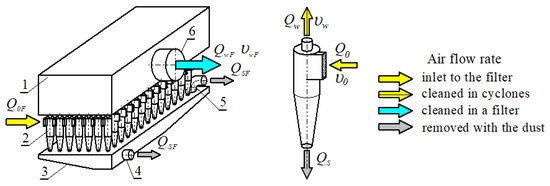
Figure 22.
Tracked vehicle air filter: 1—porous baffle, 2—cyclone D-40 multicyclone, 3—dust trap, 4/5—right/left) suction port and 6—cleaned air port.
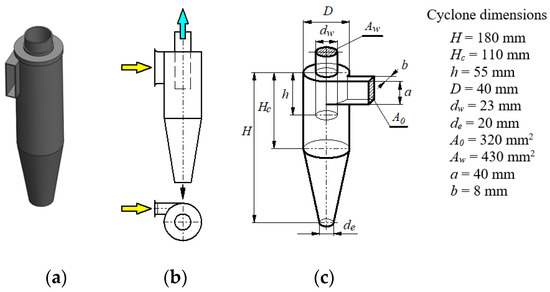
Figure 23.
Return cyclone with tangential inlet D-40: (a) general view, (b) functional diagram and (c) characteristic dimensions.
On the full engine power range, the averaged air flow velocities in the characteristic cross-sections of the air filter and single cyclone are the inlet velocity to the cyclone υ0 = 32 m/s, outlet velocity of cleaned air from the cyclone υw = 22.7 m/s and velocity in the air filter outlet port υwF = 60 m/s, respectively.
The construction of this D-40 cyclone is simple (Figure 23). In the upper part of the cylindrical hull, with internal diameter D = 40 mm, there is attached a tangentially symmetrical inlet spigot with a rectangular cross-section with sides a = 40 mm and b = 8 mm. The cylindrical outlet tube with internal diameter dw is situated coaxially in relation to the cylindrical part of the hull and sunk into it to a depth of h. The cyclone outlet tubes are connected by a common plate, which is the lower wall of the baffle filter housing. The cylindrical cyclone hull is terminated by a cone, the opening of which, with a smaller diameter de, provides a connection to the dust settling tank, which is a common dust container for all cyclones.
3.2. Proposal for Modification of D-40 Cyclone Design
The tangential inlet return cyclone D-40, due to its simple design, is susceptible to design modifications, as a result of which an improvement in performance can be expected in the form of a reduction in pressure drop or an increase in separation efficiency. However, design modifications should not compromise the basic dimensions of the cyclone, as this can have the opposite effect.
From the information resulting from the analysis conducted in Chapter 2, it appears that there are many opportunities to improve the performance of a tangential inlet return cyclone without changing its basic geometric dimensions, which are shown in Figure 24.
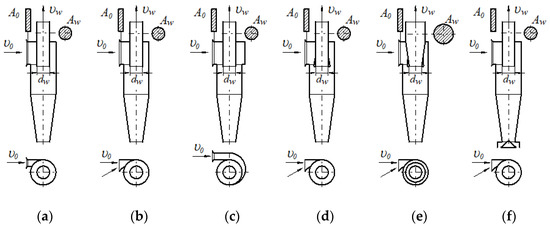
Figure 24.
Possible changes in the design of cyclone D-40: (a) original version, (b) changing the shape of the inlet from symmetrical to asymmetrical, (c) using a spiral inlet described on the cyclone’s hull, (d) giving a streamlined shape to the edges of the inlet opening of the outlet pipe, (e) changing the cylindrical outlet pipe into a conical one and (f) using a special protective cone in the lower part of the cyclone.
The design modifications proposed in b and f seem to be technologically too complicated and expensive in practical application. The use of special “protective” cones in the lower part of the cyclone (Figure 24f) prevents the entrainment of dust already separated there from the settling tank, and thus may increase the efficiency of air filtration in the cyclone. This method is recommended for use in those cyclones where extracting separated dust from the settling chamber is not applied, and in “short” cyclones, i.e., with a small ratio of the cyclone height H to its diameter D. Cyclone D-40 is characterized by a small value of the H/D parameter, but dust is extracted from the settling chamber in a continuous manner. Structural changes of the cyclone presented in points d and e are aimed at reducing pressure losses during air flow through the outlet pipe. Their share in the total flow losses in the cyclone is estimated at 75–90%. Therefore, in order to modify the design of cyclone D-40, the following solutions were selected and applied:
- A
- An asymmetrical shape of the inlet spigot was used instead of a symmetrical one, while maintaining the previous size and shape of its cross-section at the inlet to the cylindrical part (Figure 24);
- B
- A streamlined shape was given to the edges of the inlet opening of the outlet tube (Figure 25);
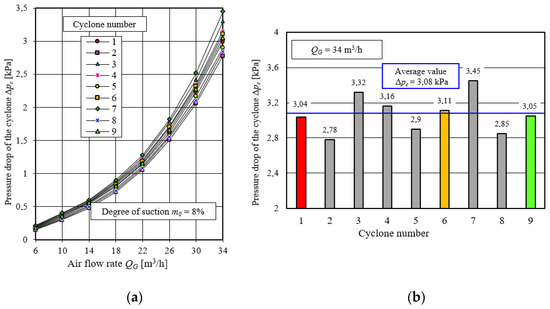 Figure 25. Preliminary test results of tracked vehicle air filter cyclones: (a) cyclone flow characteristics and (b) nominal cyclone pressure drop values.
Figure 25. Preliminary test results of tracked vehicle air filter cyclones: (a) cyclone flow characteristics and (b) nominal cyclone pressure drop values. - C
- A tapered outlet tube was used (Figure 26).
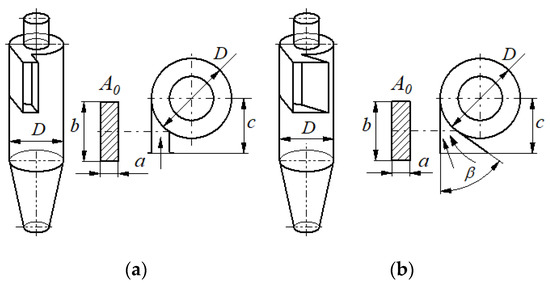 Figure 26. Modification A of cyclone D-40 design: (a) original (symmetrical) inlet channel shape and (b) asymmetrical inlet channel—Version W1.
Figure 26. Modification A of cyclone D-40 design: (a) original (symmetrical) inlet channel shape and (b) asymmetrical inlet channel—Version W1.
The modifications were performed successively (without eliminating the previous ones) on one specimen of the cyclone. As a result, three versions of the modified cyclone were obtained:
- Version W1—modification element A;
- Version W2—elements of modification A + B;
- Version W3—elements of modification A + B + C.
After the implementation of the next elements of modification A, B and C, tests were carried out on the efficiency and accuracy of filtration and pressure drop.
Three pieces of cyclones D-40 were selected to perform the proposed modifications of the design. For this purpose, preliminary tests were carried out; flow characteristics of any nine pieces of cyclones D-40 in the air flow range QG = 6–34 m3/h were performed (Figure 25). Three copies of cyclones No. 1, No. 6 and No. 9, whose pressure drops are close to the average value of the pressure drop of the nine tested cyclones, were selected to perform modifications and further tests (Figure 25b).
The design of the asymmetrical inlet consisted in rotating by an angle β = 60° the side (inner) wall of the inlet channel while maintaining the height b of the channel and its width a at the inlet to the cylindrical part of the cyclone as well as the length c of the channel (Figure 26). This causes a significant amount of dust mass to be directed (already at the inlet) towards the outer wall of the cylindrical part of the cyclone, which naturally facilitates the concentration of dust on the outer wall of the cyclone. This may cause, as proved by the research results presented in [79], an increase in the cyclone separation efficiency.
Modification B of cyclone D-40 consisted of making the edges of the inlet opening of the two outlet tubes streamlined (Figure 27). The streamlined shape of the inlet opening of the outlet tube was given by applying a ring tapering in the upward direction of the cyclone on the surface of the outlet tube from the external side. The wall of the outlet tube with a thickness of g = 1 mm and the superimposed ring was rounded with a radius of R = 2 mm, maintaining the internal diameter of the outlet tube dw. The resulting narrowing of “z” between the internal wall of the cyclone and the external surface of the ring (Figure 27) causes an increase in gas flow velocity at this point, but this should not have a significant effect on the increase in pressure drop of the cyclone.

Figure 27.
Modification of D-40 cyclone design—Version W2: (a) original cyclone version, (b) modification component B and (c) modification A + B.
This eliminated the contraction phenomenon that occurs when air enters the inlet tube opening with sharp edges. The contraction phenomenon caused narrowing of the cross-sectional area of the stream Ak, as a result of which it is smaller than the cross-sectional area of the inlet opening Aw (Figure 28). There is an increase in flow velocity at this location and consequently an increase in pressure drop.
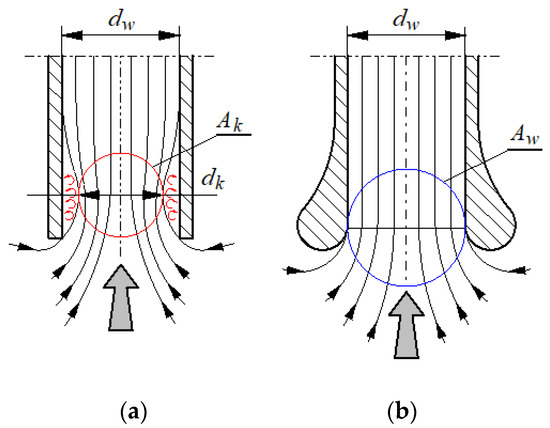
Figure 28.
Air inflow into the cylindrical tube: (a) with sharp inlet opening edges and (b) with streamlined inlet opening shape.
Modification C of cyclone D-40 consisted of replacing the existing cylindrical outlet tube of inner diameter dw with a tube of truncated cone shape, the smaller diameter of which equals the inner diameter of the outlet tube dw = 23 mm (Figure 29). The conical outlet tube was made as a diffuser with an opening angle of αs = 7°. For this value of the angle, there is no detachment of the jet from the walls or formation of vortices, and the pressure drop coefficient has the smallest value [98]. Therefore, in the duct after the cyclone, there is a decrease in the velocity of the flow in the air and thus a decrease in the pressure drop of the cyclone represented by the relation:
where ρp is the density of air and ξ is the resistance coefficient of air flow through cyclone.
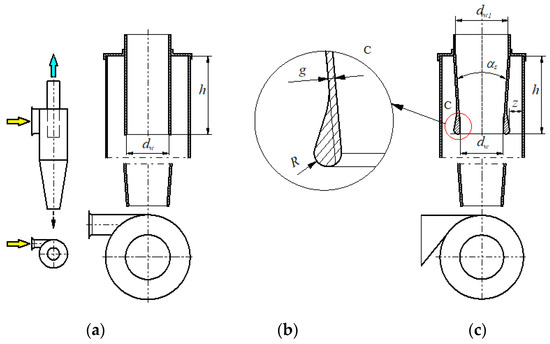
Figure 29.
Modification of D-40 cyclone design—Version W3: (a) original cyclone version, (b) element C of modification and (c) modification A + B + C.
3.3. Experimental Testing of Cyclones
The specific aim of the research was to determine the effect of performed construction modifications of three (No. 1, No. 6 and No. 9) copies of cyclones D-40 on their performance. After each performed modification of the cyclone construction, its influence on the characteristics was evaluated:
- Separation efficiency φc = f(QG);
- Pressure drop Δpc = f(QG).
After performing the last element of cyclone modification (element C), cyclone filtration accuracy was additionally determined by measuring the number and size of dust grains in the air stream QG behind the cyclone:
- Filtration accuracy dzmax = f(QG).
The above characteristics were also performed for three (No. 1, No. 6 and No. 9) copies of cyclones D-40 before their modification.
3.3.1. Methodology and Test Conditions
Testing of the D-40 cyclones was performed on a special stand, the diagram of which is shown in Figure 30. Testing was performed for an air stream within the range QGmin–QGmax resulting from the number of cyclones used in the filter multicyclone and the demand of air by the engine (within the rotational speed range nmin–nmax), for which the filter is intended. Thus, the cyclone outlet air flow rate was changed in the range QG = 6–34 m3/h, which corresponds to the velocity in the cyclone outlet duct υw = 4–22.7 m/s. Tests were conducted with the assumed constant concentration of dust in the air s = 1 g/m3 with test dust and degree of ejective dust extraction from the cyclone settling chamber m0 = 8%.
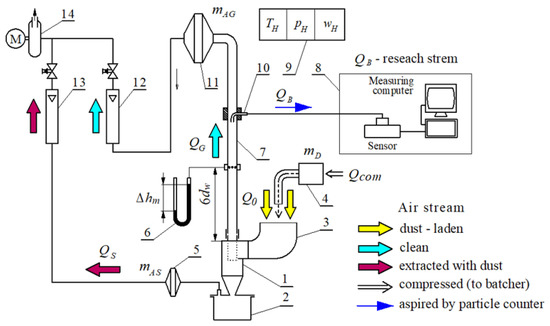
Figure 30.
Schematic of cyclone test stand: 1—cyclone; 2—dust settler; 3—dust chamber; 4—dust dispenser; 5—absolute filter of dust extraction duct; 6—liquid manometer U-tube; 7—cyclone pressure drop measuring duct; 8—particle counter; 9—ambient air temperature, pressure and humidity measuring set; 10—measuring probe; 11—absolute filter of main duct; 12, 13—rotameters of main and extraction flux measuring, respectively; 14—fan producing air flux.
The stand was equipped with a particle counter enabling determination of the number and size of dust grains in the air stream behind the cyclone from the range of 0.7–100 m, in i = 32 measurement intervals, limited by the diameters (dpimin–dpimax). The widths of the measuring compartments could be freely programmed. The sensor of the device is adapted to work at the maximum concentration of pollution particles in the air up to 1000 pieces/mL, which corresponds to the mass concentration of air dust s ≈ 0.25 g/m3.
The measuring line was terminated with an absolute filter, which is used to determine the mass of mAG dust flowing through the cyclone and, consequently, to determine the separation efficiency c of the cyclone. At the same time, the absolute filter prevented dust from entering the rotameter. The duration of one measurement (time of uniform dosing and distribution of test dust at air dust concentration s = 1 g/m3) was assumed tpom = 3 min. The test dust used was PTC-D, which is a domestic substitute for AC-fine dust, whose granulometric and chemical composition is given in Figure 31 [99].
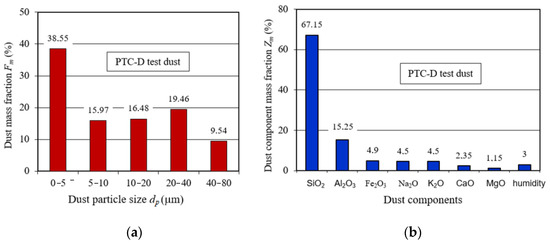
Figure 31.
PTC-D test dust: (a) size distribution and (b) chemical composition [99].
The separation efficiency c of the cyclone was determined by the mass method for successively determined values of the air stream within the range QG = 6–34 m3/h (in equal intervals, every 4 m3/h) and for corresponding values of the suction flows QS for the assumed degree of ejection of dust from the cyclone settling pond m0 = 8%.
For each measurement point p = I, II, III … k, starting from QG = 6 m3/h, j = 5 measurements were made successively, calculating for each measurement the separation efficiency φcj of the cyclone from the relation:
where mZcj is the dust mass retained by the cyclone and mDc is the dust mass dosed to the cyclone at the assumed time tpom.
The mass of dust dosed to the cyclone mDcj was determined after each measurement as the difference of the mass of the doser before and after the measurement. The mass of dust retained by the cyclone was determined after each measurement from the relationship:
where mAGj is the mass of dust retained by the absolute filter of the main duct determined as the difference of the mass of the absolute filter after and before the measurement.
The mass of the dust dispenser container and the mass of dust retained by the absolute filter were determined with an analytical balance with a measuring range of 220 g and an accuracy of 0.1 mg.
The pressure drop Δpc of the cyclone was determined after each measurement (completion of dust dosing) based on the measured static pressure Δhm (mm H2O) at a distance of 6 dw from the front plane of the cyclone hull, where dw is the internal diameter of the cyclone outlet duct.
The dust concentration in the cyclone inlet air was determined after each measurement using the relation:
where tpom is the time at which the dust mass mDcj was dosed uniformly into the cyclone inlet air stream Q0.
After a cycle of j = 5 measurements at a given measurement point p, the average values of separation efficiency, pressure drop and dust concentration in the air were calculated.
During the measurement, at time tcz = ½ tpom, the procedure of measuring the number and size of dust grains in the cyclone outlet air was started in the particle counter. The Upi contribution of dust grains from each measurement interval (dpimin–dpimax) to the total number of dust grains from all measurement intervals i was calculated.
The largest dust grain size dpimax in the cyclone exhaust air was read from each measurement interval (dpimin–dpimax), which is the filtration accuracy of the cyclone under these conditions.
3.3.2. Analysis of Test Results of Original Version Cyclones
The characteristics of separation efficiency φc = f(QG) of three (No. 1, 6 and 9) cyclones D-40 in the original version differ slightly as to the value (Figure 32), but their course is similar and consistent with the information given by many authors of research papers. With the increase in the value of the air stream QG, the separation efficiency φc of the tested cyclones increases rapidly and, in the range QG = 18–26 m3/h (υw = 12–14.7 m/s), reaches the maximum value φcmax ≅ 94.8%, after which it decreases slightly, and at the value of the stream QG = 34 m3/h, it reaches varied values of the separation efficiency in the range 93.8–94.2%.
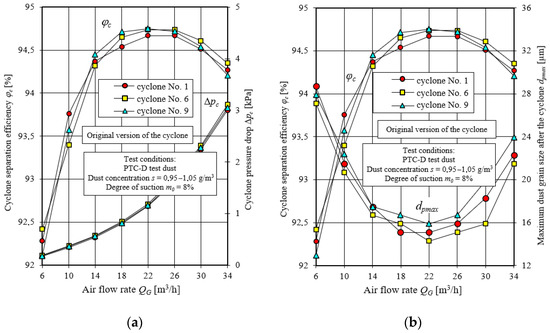
Figure 32.
Characteristics of the original D-40 cyclones: (a) separation efficiency φc = f(QG) and pressure drop Δpc = f(QG); (b) separation efficiency and accuracies φc = f(QG), dpmax = f(QG).
Such a course of changes in the separation efficiency φc = f(QG) is mainly the result of mutual relations between the inertia force Pd acting on the dust grain and the aerodynamic force PR of the gas stream interaction. Along with an increase in the stream of air flowing through the cyclone (flow velocity), the values of both forces are increasing, and for higher values of the stream (in the tested cyclone, after exceeding QG = 18 m3/h), the increase in the aerodynamic force PR begins to be faster than the inertia force Pd, which causes braking the movement of grains; thus, their secondary entrainment by the stream (vortex) of air outlet from the cyclone may occur. As a consequence, the separation efficiency of the cyclone decreases. On the other hand, according to the authors of [79], the decrease in effectiveness is also caused by the fact that large dust grains hitting the cyclone wall at high speed are reflected, and then they are again entrained by the air stream and carried with it to the cyclone outlet.
The pressure drop of the selected cyclones changes parabolically in the range of the tested flux and, for the maximum value of QGmax = 34 m3/h, is in the range of 3.01–3.11 kPa.
The change in separation efficiency φc of the cyclones and the simultaneous change in the size of the maximum dpmax of the dust grains found in the exhaust air from the tested cyclones in the original version is shown in Figure 32. A clear relationship between the two parameters can be seen. An increase in the air flow rate in the range QG = 6–22 m3/h causes an intensive increase in the separation efficiency φc of the cyclones and a decrease in the size of the maximum dust grains dpmax, which for QG = 6 m3/h, take values in the range dpmax = 27.1–28.9 μm. With a further increase in the air flow rate QG, there is a slight decrease in the separation efficiency c of the cyclones and an increase in the size of the maximum dust grains dpmax. For QG = 34 m3/h, the sizes of dust grains dpmax = 18.3–23.9 μm.
The presence of large dust grains in the air behind the cyclone at higher air flow rates may be due to the fact that the dust grains, while performing a swirling motion, hit the cyclone wall at high speed, bounce off it and then are again entrained by the air flow and lifted to the cyclone outlet. These are individual grains, but of large size and mass. Therefore, the dust grain with the largest size dp = dpmax found in the air behind the cyclone was used as a criterion for evaluating the accuracy of air filtration in the cyclone.
The PTC-D test dust used for testing, which is a representation of road dust sucked together with the intake air for motor vehicle engines, is a polydisperse dust of varied chemical composition (Figure 30) with a dominant share of SiO2 silica. The chemical composition of the dust makes the grains have different densities, which for the main components of the dust have a value in g/cm3: for silica SiO2—2.65, for alumina Al2O3—3.99, for iron oxide Fe2O3—5.24 and for calcium oxide CaO—3.40. Therefore, the dust grains with the same volume have a different mass, which determines the force of inertia. In addition, the dust grains have an irregular shape, which affects the value of the aerodynamic force PR. For these reasons, the separation in the cyclone from the air containing road dust grains of grains only above a certain diameter dpgr is impossible, as shown in Figure 33 and Figure 34.

Figure 33.
Numerical contributions of Up of dust grains in the air upstream and downstream of the tested cyclone D-40 (No. 1—original version) for different values of air flow QG.
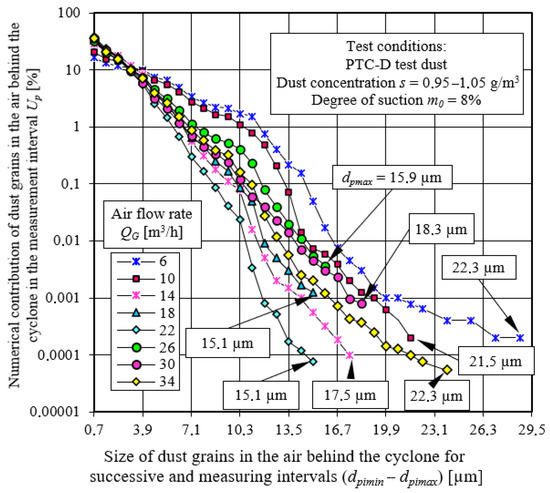
Figure 34.
The numerical proportion of dust grains in the air downstream of the tested cyclone D-40 (No. 1—original version) and the maximum dust grain size dpmax for different values of airflow QG.
For the test dust used in this study, the grains do not exceed the size of dpmax = 80 μm. The experimentally determined granulometric composition of the PTC-D test dust (Up number shares of dust grains) in the inlet air to cyclone No. 1 (original version) is shown in Figure 33. With the increase in the size of dust grains, the Up number shares take on increasingly larger values to reach a maximum value of Upmax = 16% for dp = 4 μm, after which they decrease sharply again. For grain sizes dp = 15 μm, the numerical proportion Up does not exceed 1.5%. The dust in the outlet air from the cyclone has a significantly different granulometric composition than at the inlet. The maximum values of the Up shares occur for dust grains with the smallest size registered by the counter, i.e., for dp = 0.7 μm, and then, along with an increase in the size of grains, they decrease rapidly. In the last measurement interval, there is usually one dust grain of size dp = dpmax, and its value depends on the value of the air stream flowing through the cyclone (Figure 34). Similar results were obtained by the author of [100], testing a tangential inlet return cyclone with diameter D = 31.1 mm in the range of air flow rate QG = 30.24–66.24 m3/h using test dust with the density ρzp = 0.98 g/cm3.
The numerical shares of Up of the dust grains and the size of the dust grain dpmax in the air behind the cyclone decrease with the increasing air flow rate (flow velocity), but only up to a certain value of QG ≈ 22 m3/h (υw = 14.7 m/s). With a further increase in the flux QG, there is again an increase in the value of Up and the particle size of dust dpmax.
In the case of the investigated cyclones, a characteristic dust grain size dpmax of dp ≈ 3.1 μm can be observed, whose numerical shares of Up in the air behind the cyclone do not depend on the value of the air flow QG. For the same measurement intervals, with an increase in the value of the air flow in the range QG = 6–22 m3/h, the numerical shares Up of the dust grains with sizes above dp ≈ 3.1 μm decrease, and below this value they increase—Figure 35. An increase in the numerical shares Up of the dust grains with sizes below dp ≈ 3.1 μm may indicate that these grains are not retained in the cyclone and are left together with the air.
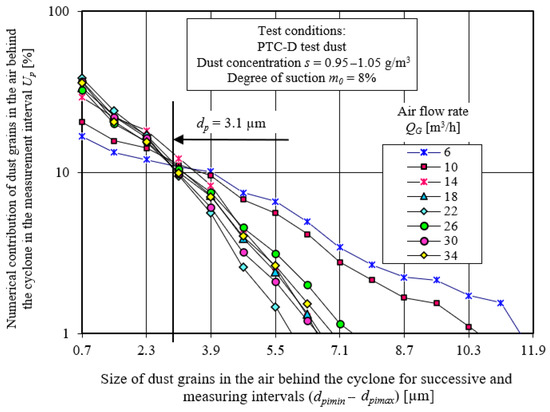
Figure 35.
Numerical contribution of Up of dust grains in the air behind the tested cyclone D-40 (cyclone No. 1—original version) for different values of air flow QG.
Theoretically, in the air behind the cyclone at fixed flow conditions (constant value of QG flux), there should be only dust grains below a certain limit size dpgr, the value of which can be determined from the relation given in [34,38] and modified by the author:
where m is the power exponent of the equation contained in the range 0.5–0.9, μg is the gas viscosity and ρzp is the density of dust grains.
In the case of the tested cyclone, calculated according to Equation (6) for the basic components of dust (SiO2, Al2O3 and Fe2O3), the dimensions of the limit grains dpgr take the values presented in Table 2.

Table 2.
Results of calculations of the limit size dpgr of the dust grains.
The calculated dzgr sizes vary slightly and take very small values (0.68–2.23 µm), much smaller than the dust grain sizes dpmax recorded in the air behind the cyclone under study. As the air flow rate through the cyclone QG and the density of dust grains increase, the dzgr sizes take on smaller and smaller values, which is consistent with the general theory of cyclone operation.
3.3.3. Analysis of Test Results of Cyclones with Modifications
Results of tests of the influence of successive (A, B and C) elements of cyclones construction modifications on the characteristics of separation efficiency φc = f(QG) and pressure drop Δpc = f(QG), are presented on the example of cyclone No. 1. Replacement of the symmetrical inlet with an asymmetrical inlet (version I of the cyclone—modification element A) causes an increase of approx. 4% of separation efficiency of cyclone c in the range of flux QG = 6–22 m3/h, with preservation of the previous character of the modification Figure 36. This slight increase in separation efficiency could be caused by the fact that the asymmetrical inlet ensured obtaining such a distribution of dust in its cross-section, in which its basic mass was gathered at the external wall of the cylindrical part of the cyclone. Movement of dust grains towards the walls causes an increase in dust concentration in their vicinity. As a result of grains colliding with each other at the cyclone walls, dust coagulation may occur, which consequently increases the effect of gravitational force and accelerates dust release, especially of small grains. Changing the shape of the inlet port did not cause any noticeable changes in the pressure drop Δpc = f(QG) in relation to the course and value.
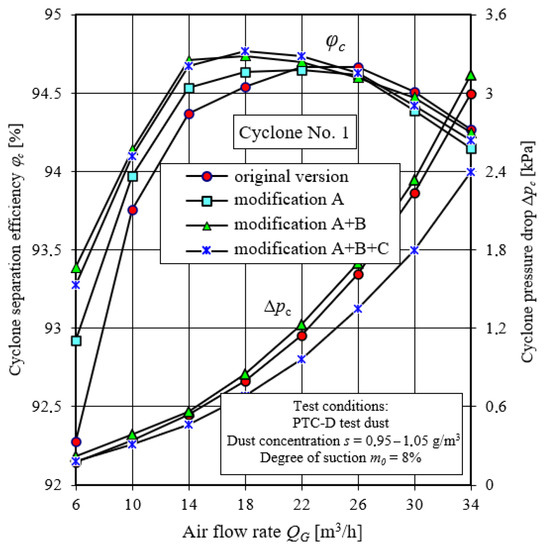
Figure 36.
Change in separation efficiency φc = f(QG) and pressure drop Δpc = f(QG) of cyclone D-40 (No. 1) for successive A, B and C cyclone design modification elements.
Application of the streamlined shape of the inlet hole of the outlet pipe (version II of the cyclone—elements of modifications A + B) caused a further increase (about 0.5%) of separation efficiency c of the cyclone in the range QG = 6–22 m3/h. Above QG = 22 m3/h, an opposite effect of A + B modification was observed, as a slight decrease of separation efficiency of the cyclone took place. At the same time, there was an approximately 6% increase in pressure drop pc caused most likely by the increase in aerosol velocity in the “z” constriction, which was created after making a streamlined ring on the outer surface of the outlet tube (Figure 28). The increase of aerosol velocity in the “z” constriction caused the dust grains of smaller size and mass to acquire the velocity and inertial force necessary to separate them from the air, which was reflected in the increase of cyclone separation efficiency in the range of smaller QG air flows. Thus, the maximum cyclone separation efficiency had a higher value of φc = 94.77% and moved its position from QG = 22 m3/h to QG = 18 m3/h.
Replacement of the cylindrical outlet tube with a conical one with preservation of the original inner diameter of the dw hole and expanding towards the outlet together with the streamlined shape of the inlet hole (version III of the cyclone—elements of modification A + B + C) caused, first of all, a significant decrease. The decrease in pressure drop of the cyclone results from the decrease (from υw = 22.7 m/s to υw = 14 m/s for QG = 34 m3/h) of the outlet velocity in the cyclone, which happens as a result of increasing the diameter of the cyclone outlet pipe. There was also a non-significant decrease in separation efficiency, compared to the cyclone version II, over the entire range of air flow values QG.
The change of separation efficiency c and the change of the size of the maximum dpmax of the dust grains in the air behind the tested cyclone No. 1 in the original version and the cyclone version III (elements of the modifications A + B + C) are shown in Figure 37. There is a clear decrease in the size of the maximum dpmax of the dust grains for the extreme values of the air flow (QG = 6 m3/h and QG = 34 m3/h) and an increase in this size for the middle values of QG.
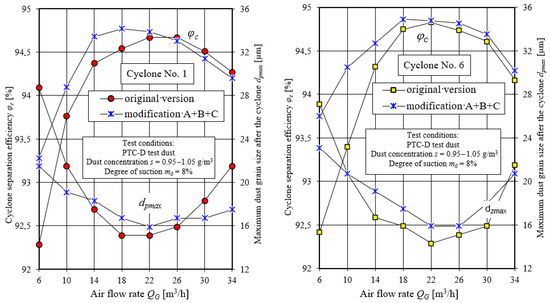
Figure 37.
Variation of separation efficiency φc = f(QG) and maximum dust grain size values dpmax = f(QG) in the QG exhaust air stream of cyclone No. 1 and No. 6 in the original version and after design modification—version III.
The design modification performed on the cyclones primarily resulted in a significant approximately 30% decrease in cyclone pressure drop compared to their original version. There was a slight (about 1%) increase in separation efficiency c of cyclones for lower values (QG = 6–22 m3/h) of air flows.
For the remaining two specimens of cyclones D-40 (No. 6 and No. 9), the modification of the design into successive elements A, B and C caused similar changes as in cyclone No. 1 in the characteristics of separation efficiency φc = f(QG) and filtration accuracy dpmax = f(QG) and pressure drop Δpc = f(QG) in relation to the course and values (Figure 37).
The modification of the cyclone resulted in an increase in the fractional efficiency of the cyclone, as evidenced by a decrease in the proportion of the maximum size dpmax of dust grains in the air downstream of the cyclone in terms of the minimum and maximum values of the air flow rate QG passing through the cyclone.
From the test results presented in Figure 36 and Figure 37, it can be seen that the D-40 cyclone should operate within a narrow range of changes in air flow QG = 18–26 m3/h, resulting from maximum separation efficiency and minimum concentration of large-sized dust grains. Widening this range will cause the cyclone to operate at a lower separation efficiency and lower filtration accuracy, which will increase the mass of dust retained on the second filtration stage, and thus cause an accelerated increase in its pressure drop.
4. Conclusions
In this paper, an experimental evaluation of a tangential inlet reciprocating cyclone design modification of an air filter multicyclone was performed to increase the filtration efficiency of the inlet air to a tracked vehicle engine. Three modifications to the cyclone design were proposed and performed on three specimens. The symmetrical inlet of the cyclone inlet channel was replaced with an asymmetrical inlet. The cylindrical outlet tube was modified and replaced with a conical tube, and the edges of the inlet opening were additionally given a streamlined shape. After each modification performed, an experimental evaluation of the cyclone design changes was performed. The influence of the modifications on the cyclone’s efficiency and flow resistance characteristics was examined. Next, modifications of the cyclone were performed on the same specimen without removing the previous modifications. Tests were performed in the air flow range QG = 5–30 m3/h resulting from the operation of the engine in the rotational speed range nmin–nN. Polydisperse test dust with grain size range dpmax = 80 µm was used for testing. Improvements in cyclone performance were obtained in terms of filtration efficiency and accuracy as well as pressure drop. The following conclusions were drawn from the conducted research:
- (1)
- Although there are many structural possibilities of increasing the effectiveness of cyclones, not all solutions, due to their too complicated construction, can be used in cyclones used in motor vehicle engine inlet air filters. The effect in the form of an increase in separation efficiency or a decrease in flow resistance may be disproportionally small in relation to the costs incurred.
- (2)
- To modify the cyclones, which are the elements of the multicyclone of the motor vehicle air filter, the following solutions can be used practically: change of the shape of the inlet port—replacement of the symmetric inlet with an asymmetric one, introduction of a streamlined shape of the inlet opening of the outlet duct and change of the shape of the outlet duct (outlet tube) from cylindrical to conical. It may be technologically difficult to make a streamlined shape of the outlet tube inlet opening.
- (3)
- The separation efficiency of the tested cyclones (reciprocating cyclones with tangential inlet) with respect to polydisperse dust with grain size up to dpmax = 80 µm increases with the increase of air flow QG (inlet velocity 0) up to the value of φcmax = 94.8%, and then slightly decreases. Such a character of the course of φc = f(QG) and the values of the obtained efficiencies are consistent with the information provided in the literature by the authors of research papers.
- (4)
- For steady flow conditions (QG = const.), the number of dust grains in the air behind the cyclone systematically decreases as their size increases until they disappear completely. In the last measurement interval, there is usually one dust grain with a maximum size of dp = dpmax, which indicates the filtration accuracy. As the air flow rate QG increases, the dimension of the dust grain dpmax takes on smaller and smaller values, which corresponds to the maximum filtration efficiency, after which it increases again. There is no clear separation (at the boundary grain size dpgr) between the dust grains retained by the cyclone and those leaving the cyclone with the air. The reason for this phenomenon is the polydispersity of the dust, the density, size and shape of the dust grains.
- (5)
- Modification of the design of cyclones does not cause significant changes in the characteristics of separation efficiency φc and pressure drop Δpc. A visible effect of the performed modifications of the cyclones’ construction is, first of all, a significant 30% decrease in the pressure drop within the whole range of the examined flux QG, which is an effect of replacing the cylindrical cyclone outlet tube with a conical one. In addition, there is an approximately 1% increase in separation efficiency φc in the range of the smallest values of air flux QG and a shift in the maximum separation efficiency φcmax towards smaller values of air flux QG, which may result from the use of an asymmetrical inlet duct and the streamlined shape of the inlet opening of the outlet tube.
- (6)
- Modification of the cyclones by elements A, B and C results in a clear decrease in the dimensions of the maximum dpmax of the dust grains for the extreme (QG = 6 m3/h i QG = 34 m3/h) values of the air stream (Figure 37) and an increase in the dimensions dpmax for the air stream in the range QG = (14–26) m3/h. At the same time, in this range, the cyclone obtains the maximum values of cyclone filtration efficiency, which indicates the range of air stream in which the operation of this cyclone should take place.
In this study, the filtration efficiency of a single cyclone was improved by making three modifications to its design. The activities brought the expected results in terms of improving the filtration efficiency of the cyclone, so it is advisable to conduct further research on tangential inlet return cyclones in terms of increasing the separation efficiency and accuracy and reducing the pressure drop. Other modifications of this cyclone are possible, such as using a special cone on the outlet of separated dust, using more inlet channels or changing the inlet channel to a diagonal one that is directed upwards. This will be the subject of further research by the author. In the available literature there are results of positive research in this area. However, modifications should be performed and evaluated experimentally on a selected cyclone. Experimental research is expensive and labor intensive, but it is the most reliable research method.
Funding
The article was written as part of the implementation of the university research grant No. UGB 759/2022.
Institutional Review Board Statement
Not applicable.
Informed Consent Statement
Not applicable.
Data Availability Statement
Data are contained within the article.
Conflicts of Interest
The author declares no conflict of interest.
References
- Barris, M.A. Total FiltrationTM: The Influence of Filter Selection on Engine Wear, Emissions, and Performance; SAE Technical Paper 952557; SAE: Warrendale, PA, USA, 1995. [Google Scholar]
- Schaeffer, J.W.; Olson, L.M. Air Filtration Media for Transportation Applications. Filtr. Sep. 1998, 35, 124–129. [Google Scholar]
- Jaroszczyk, T.; Pardue, B.A.; Heckel, S.P.; Kallsen, K.J. Engine air cleaner filtration performance—Theoretical and experimental background of testing. In Proceedings of the AFS Fourteenth Annual Technical Conference and Exposition, Tampa, FL, USA, 1 May 2001. Included in the Conference Proceedings (Session 16). [Google Scholar]
- Dziubak, T. Zapylenie powietrza wokół pojazdu terenowego. Wojsk. Przegląd Tech. 1990, 3, 154–157. (In Polish) [Google Scholar]
- Burda, S.; Chodnikiewicz, Z. Konstrukcja i badania pyłowe filtrów powietrza silnika czołgowego. Bull. Mil. Univ. Technol. 1962, 3, 12–34. (In Polish) [Google Scholar]
- Juda, J.; Nowicki, M. Urządzenia Odpylające; Państwowe Wydawnictwo Naukowe: Warszawa, Poland, 1986. (In Polish) [Google Scholar]
- Balicki, W.; Szczeciński, S.; Chachurski, R.; Kozakiewicz, A.; Głowacki, P.; Szczeciński, J. Problematyka filtracji powietrza wlotowego do turbinowych silników śmigłowcowych. Trans. Inst. Aviat. 2009, 199, 25–30. [Google Scholar]
- Bojdo, N.; Filippone, A. Effect of Desert Particulate Composition on Helicopter Engine Degradation Rate. In Proceedings of the 40th European Rotorcraft Forum, Southampton, UK, 2–5 September 2014. [Google Scholar] [CrossRef]
- Smialek, J.L.; Archer, F.A.; Garlick, R.G. Turbine airfoil degradation in the persian gulf war. JOM 1994, 46, 39–41. [Google Scholar] [CrossRef]
- Vogel, A.; Durant, A.J.; Cassiani, M.; Clarkson, R.J.; Slaby, M.; Diplas, S.; Krüger, K.; Stohl, A. Simulation of Volcanic Ash Ingestion Into a Large Aero Engine: Particle–Fan Interactions. ASME J. Turbomach. 2019, 141, 011010. [Google Scholar] [CrossRef] [Green Version]
- Summers, C.E. The physical characteristics of road and field dust. SAE Trans. 1925, 20, 178–197. [Google Scholar] [CrossRef]
- Pinnick, R.G.; Fernández, G.; Hinds, B.D.; Bruce, C.W.; Schaefer, R.W.; Pendleton, J.D. Dust Generated by Vehicular Traffic on Unpaved Roadways: Sizes and Infrared Extinction Characteristics. Aerosol Sci. Technol. 1985, 4, 99–121. [Google Scholar] [CrossRef]
- Long, J.; Tang, M.; Sun, Z.; Liang, Y.; Hu, J. Dust Loading Performance of a Novel Submicro-Fiber Composite Filter Medium for Engine. Materials 2018, 11, 2038. [Google Scholar] [CrossRef] [Green Version]
- Jaroszczyk, T.; Wake, J.; Fallon, S.L.; Connor, M.J. Development of Motor Vehicle Ventilation System Particulate Air Filters; SAE Technical Paper Series 962241; International Truck & Bus Meeting & Exposition: Detroit, MI, USA, 1996. [Google Scholar]
- Maddineni, A.K.; Das, D.; Damodaran, R.M. Numerical investigation of pressure and flow characteristics of pleated air filter system for automotive engine intake application. Sep. Purif. Technol. 2018, 212, 126–134. [Google Scholar] [CrossRef]
- Jaroszczyk, T.; Petrik, S.; Donahue, K. Recent Development in Heavy Duty Engine Air Filtration and the Role of Nanofiber Filter Media. J. KONES Powertrain Transp. 2009, 16, 207–216. [Google Scholar]
- Rieger, M.; Hettkamp, P.; Löhl, T.; Madeira, P.M.P. Effcient Engine Air Filter for Tight Installation Spaces. ATZ Heavy Duty Worldw. 2019, 12, 56–59. [Google Scholar] [CrossRef]
- Tian, X.; Ou, Q.; Liu, J.; Liang, Y.; Pui, D.Y. Influence of pre-stage filter selection and face velocity on the loading characteristics of a two-stage filtration system. Sep. Purif. Technol. 2019, 224, 227–236. [Google Scholar] [CrossRef]
- Muschelknautz, U. Design criteria for multicyclones in a limited space. Powder Technol. 2019, 357, 2–20. [Google Scholar] [CrossRef]
- Muschelknautz, U. Comparing Efficiency per Volume of Uniflow Cyclones and Standard Cyclones. Chem. Ing. Tech. 2020, 93, 91–107. [Google Scholar] [CrossRef]
- Otanocha, O.B.; Lin, L.; Zhou, Y.; Zhong, S.; Zhu, L. Picosecond laser surface micro-texturing for the modification of aerodynamic and dust distribution characteristics in a multi-cyclone system. Cogent Eng. 2016, 3, 1152746. [Google Scholar] [CrossRef]
- Barbolini, M.; Di Pauli, F.; Traina, M. Simulation der Luftfiltration zur Auslegung von Filterelementen. MTZ-Mot. Z. 2014, 75, 52–57. [Google Scholar] [CrossRef]
- Bojdo, N. Rotorcraft Engine Air Particle Separation. Doctoral Thesis, University of Manchester, Manchester, UK, 2012. Available online: https://www.escholar.manchester.ac.uk/uk-ac-man-scw:183545 (accessed on 2 April 2021).
- Szczepankowski, A.; Szymczak, J.; Przysowa, R. The Effect of a Dusty Environment Upon Performance and Operating Parameters of Aircraft Gas Turbine Engines. In Proceedings of the Specialists’ Meeting—Impact of Volcanic Ash Clouds on Military Operations NATO AVT-272-RSM-047, Vilnius, Lithuania, 17 May 2017. [Google Scholar]
- Worek, J.; Badura, X.; Białas, A.; Chwiej, J.; Kawoń, K.; Styszko, K. Pollution from Transport: Detection of Tyre Particles in Environmental Samples. Energies 2022, 15, 2816. [Google Scholar] [CrossRef]
- Cichowicz, R.; Dobrzański, M. Analysis of Air Pollution around a CHP Plant: Real Measurements vs. Computer Simulations. Energies 2022, 15, 553. [Google Scholar] [CrossRef]
- Ciobanu, C.; Tudor, P.; Istrate, I.-A.; Voicu, G. Assessment of Environmental Pollution in Cement Plant Areas in Romania by Co-Processing Waste in Clinker Kilns. Energies 2022, 15, 2656. [Google Scholar] [CrossRef]
- Kanageswari, S.V.; Tabil, L.G.; Sokhansanj, S. Dust and Particulate Matter Generated during Handling and Pelletization of Herbaceous Biomass: A Review. Energies 2022, 15, 2634. [Google Scholar] [CrossRef]
- Luo, H.; Zhou, W.; Jiskani, I.M.; Wang, Z. Analyzing Characteristics of Particulate Matter Pollution in Open-Pit Coal Mines: Implications for Green Mining. Energies 2021, 14, 2680. [Google Scholar] [CrossRef]
- Jaroszczyk, T.; Fallon, S.L.; Liu, Z.G.; Heckel, S.P. Development of a Method to Measure Engine Air Cleaner Fractional Effi-ciency. SAE Trans. 1999, 1089, 9–18. [Google Scholar]
- Grafe, T.; Gogins, M.; Barris, M.; Schaefer, J.; Canepa, R. Nanofibers in Filtration Applications in Transportation. In Proceedings of the Filtration 2001 International Conference and Exposition of the INDA (Association of the Nowovens Fabric Industry), Chicago, IL, USA, 3–5 December 2001; Available online: https://www.yumpu.com/en/document/read/7555561/nanofiber-in-filtration-applications-in-transportation-donaldson- (accessed on 22 May 2022).
- Schulze, M.; Taufkirch, G. Papierluftfilter Nutzfahrzeugen. MTZ Mot. Z. 1991, 1991, 52. [Google Scholar]
- Duan, J.; Gao, S.; Lu, Y.; Wang, W.; Zhang, P.; Li, C. Study and optimization of flow field in a novel cyclone separator with inner cylinder. Adv. Powder Technol. 2020, 31, 4166–4179. [Google Scholar] [CrossRef]
- Cortés, C.; Gil, A. Modeling the gas and particle flow inside cyclone separators. Prog. Energy Combust. Sci. 2007, 33, 409–452. [Google Scholar] [CrossRef]
- Zhang, W.; Zhang, L.; Yang, J.; Hao, X.; Guan, G.; Gao, Z. An experimental modeling of cyclone separator efficiency with PCA-PSO-SVR algorithm. Powder Technol. 2019, 347, 114–124. [Google Scholar] [CrossRef]
- Dziubak, T.; Bąkała, L.; Karczewski, M.; Tomaszewski, M. Numerical research on vortex tube separator for special vehicle engine inlet air filter. Sep. Purif. Technol. 2019, 237, 116463. [Google Scholar] [CrossRef]
- Wang, J.; Kim, S.C.; Pui, D.Y.H. Figure of Merit of Composite Filters with Micrometer and Nanometer Fibers. Aerosol Sci. Technol. 2008, 42, 722–728. [Google Scholar] [CrossRef]
- Dirgo, J.; Leith, D. Performance of Theoretically Optimised Cyclones. Filtr. Sep. 1985, 22, 119–125. [Google Scholar]
- Juda, J. Pomiary Zapylenia i Technika Odpylania; WNT: Warszawa, Poland, 1968. (In Polish) [Google Scholar]
- Kabsch, P. Odpylanie i Odpylacze; WNT: Warszawa, Poland, 1992. (In Polish) [Google Scholar]
- Robinson, K.S.; Hamblin, C. Ivestigating Droplet Collection in Helices and a Comparison with Conventional Demisters. Filtr. Sep. 1986, 24, 166. [Google Scholar]
- Swift, P. An Empirical Approach to Cyclone Design and Application. Filtr. Sep. 1986, 23, 24–27. [Google Scholar]
- Warych, J. Oczyszczanie Gazów-Procesy i Aparatura; WNT: Warszawa, Poland, 1998. (In Polish) [Google Scholar]
- Wheeldon, J.M.; Burnard, G.K. Performance of Cyclones in the Off-Gas Path of a Pressurised Fluidised Bed Combustor. Filtr. Sep. 1987, 24, 178–187. [Google Scholar]
- Gimbun, J.; Chuah, T.G.; Choong, T.S.Y.; Fakhru’L-Razi, A. A CFD Study on the Prediction of Cyclone Collection Efficiency. Int. J. Comput. Methods Eng. Sci. Mech. 2005, 6, 161–168. [Google Scholar] [CrossRef]
- Leith, D.; Mehta, D. Cyclone performance and design. Atmosp. Environ. 1973, 7, 527–549. [Google Scholar] [CrossRef]
- Kim, J.C.; Lee, K.W. Experimental Study of Particle Collection by Small Cyclones. Aerosol Sci. Technol. 1990, 12, 1003–1015. [Google Scholar] [CrossRef]
- Dirgo, J.; Leith, D. Cyclone Collection Efficiency: Comparison of Experimental Results with Theoretical Predictions. Aerosol Sci. Technol. 1985, 4, 401–415. [Google Scholar] [CrossRef] [Green Version]
- Ramachandran, G.; Leith, D.; Dirgo, J.; Feldman, H. Cyclone Optimization Based on a New Empirical Model for Pressure Drop. Aerosol Sci. Technol. 1991, 15, 135–148. [Google Scholar] [CrossRef]
- Iozia, D.L.; Leith, D. The Logistic Function and Cyclone Fractional Efficiency. Aerosol Sci. Technol. 1990, 12, 598–606. [Google Scholar] [CrossRef] [Green Version]
- Karagoz, I.; Avci, A. Modelling of the Pressure Drop in Tangential Inlet Cyclone Separators. Aerosol Sci. Technol. 2005, 39, 857–865. [Google Scholar] [CrossRef]
- Hsiao, T.-C.; Huang, S.-H.; Hsu, C.-W.; Chen, C.-C.; Chang, P.-K. Effects of the geometric configuration on cyclone performance. J. Aerosol Sci. 2015, 86, 1–12. [Google Scholar] [CrossRef]
- Wu, J.-P.; Zhang, Y.-H.; Wang, H.-L. Numerical study on tangential velocity indicator of free vortex in the cyclone. Sep. Purif. Technol. 2014, 132, 541–551. [Google Scholar] [CrossRef]
- Altmeyer, S.; Mathieu, V.; Jullemier, S.; Contal, P.; Midoux, N.; Rode, S.; Leclerc, J.-P. Comparison of different models of cyclone prediction performance for various operating conditions using a general software. Chem. Eng. Process. Process Intensif. 2004, 43, 511–522. [Google Scholar] [CrossRef]
- Zhao, B. Development of a Dimensionless Logistic Model for Predicting Cyclone Separation Efficiency. Aerosol Sci. Technol. 2010, 44, 1105–1112. [Google Scholar] [CrossRef] [Green Version]
- Zhou, F.; Sun, G.; Zhang, Y.; Ci, H.; Wei, Q. Experimental and CFD study on the effects of surface roughness on cyclone performance. Sep. Purif. Technol. 2018, 193, 175–183. [Google Scholar] [CrossRef]
- Hoffmann, A.C.; Arends, H.; Sie, H. An Experimental Investigation Elucidating the Nature of the Effect of Solids Loading on Cyclone Performance. Filtr. Sep. 1991, 28, 188–193. [Google Scholar] [CrossRef]
- Zhu, Y.; Lee, K. Experimental study on small cyclones operating at high flowrates. J. Aerosol Sci. 1999, 30, 1303–1315. [Google Scholar] [CrossRef]
- Elsayed, K.; Lacor, C. The effect of cyclone inlet dimensions on the flow pattern and performance. Appl. Math. Model. 2011, 35, 1952–1968. [Google Scholar] [CrossRef] [Green Version]
- Beaulac, P.; Issa, M.; Ilinca, A.; Brousseau, J. Parameters Affecting Dust Collector Efficiency for Pneumatic Conveying: A Review. Energies 2022, 15, 916. [Google Scholar] [CrossRef]
- Le, D.K.; Yoon, J.Y. Numerical investigation on the performance and flow pattern of two novel innovative designs of four-inlet cyclone separator. Chem. Eng. Process. Process Intensif. 2020, 150, 107867. [Google Scholar] [CrossRef]
- Safikhani, H.; Zamani, J.; Musa, M. Numerical study of flow field in new design cyclone separators with one, two and three tangential inlets. Adv. Powder Technol. 2018, 29, 611–622. [Google Scholar] [CrossRef]
- Mazyan, W.; Ahmadi, A.; Brinkerhoff, J.; Ahmed, H.; Hoorfar, M. Enhancement of cyclone solid particle separation performance based on geometrical modification: Numerical analysis. Sep. Purif. Technol. 2018, 191, 276–285. [Google Scholar] [CrossRef]
- Brar, L.S.; Elsayed, K. Analysis and optimization of multi-inlet gas cyclones using large eddy simulation and artificial neural network. Powder Technol. 2017, 311, 465–483. [Google Scholar] [CrossRef]
- El-Emam, M.A.; Shi, W.; Zhou, L. CFD-DEM simulation and optimization of gas-cyclone performance with realistic macroscopic particulate matter. Adv. Powder Technol. 2019, 30, 2686–2702. [Google Scholar] [CrossRef]
- Sun, Z.; Liang, L.; Liu, Q.; Yu, X. Effect of the particle injection position on the performance of a cyclonic gas solids classifier. Adv. Powder Technol. 2019, 31, 227–233. [Google Scholar] [CrossRef]
- Lim, J.-H.; Park, S.-I.; Lee, H.-J.; Zahir, M.Z.; Yook, S.-J. Performance evaluation of a tangential cyclone separator with additional inlets on the cone section. Powder Technol. 2019, 359, 118–125. [Google Scholar] [CrossRef]
- Wang, S.; Li, H.; Wang, R.; Wang, X.; Tian, R.; Sun, Q. Effect of the inlet angle on the performance of a cyclone separator using CFD-DEM. Adv. Powder Technol. 2018, 30, 227–239. [Google Scholar] [CrossRef]
- Wasilewski, M.; Brar, L.S. Effect of the inlet duct angle on the performance of cyclone separators. Sep. Purif. Technol. 2018, 213, 19–33. [Google Scholar] [CrossRef]
- Yoshida, H.; Ono, K.; Fukui, K. The effect of a new method of fluid flow control on submicron particle classification in gas-cyclones. Powder Technol. 2005, 149, 139–147. [Google Scholar] [CrossRef]
- Mandsandulia, D.; Andersson, A.G.; Lundström, T.S. Effects of the inlet angle on the collection efficiency of a cyclone with helical-roof inlet. Powder Technol. 2017, 305, 48–55. [Google Scholar]
- Misiulia, D.; Andersson, A.G.; Lundström, T.S. Effects of the inlet angle on the flow pattern and pressure drop of a cyclone with helical-roof inlet. Chem. Eng. Res. Des. 2015, 102, 307–321. [Google Scholar] [CrossRef]
- Lim, K.; Kwon, S.-B.; Lee, K. Characteristics of the collection efficiency for a double inlet cyclone with clean air. J. Aerosol Sci. 2003, 34, 1085–1095. [Google Scholar] [CrossRef]
- Zhao, B.; Shen, H.; Kang, Y. Development of a symmetrical spiral inlet to improve cyclone separator performance. Powder Technol. 2004, 145, 47–50. [Google Scholar] [CrossRef]
- Bernardo, S.; Mori, M.; Peres, A.; Dionísio, R. 3-D computational fluid dynamics for gas and gas-particle flows in a cyclone with different inlet section angles. Powder Technol. 2006, 162, 190–200. [Google Scholar] [CrossRef]
- Chen, L.; Ma, H.; Sun, Z.; Ma, G.; Li, P.; Li, C.; Cong, X. Effect of inlet periodic velocity on the performance of standard cyclone separators. Powder Technol. 2022, 402, 117347. [Google Scholar] [CrossRef]
- Wei, Q.; Sun, G.; Gao, C. Numerical analysis of axial gas flow in cyclone separators with different vortex finder diameters and inlet dimensions. Powder Technol. 2020, 369, 321–333. [Google Scholar] [CrossRef]
- Yao, Y.; Huang, W.; Wu, Y.; Zhang, Y.; Zhang, M.; Yang, H.; Lyu, J. Effects of the inlet duct length on the flow field and performance of a cyclone separator with a contracted inlet duct. Powder Technol. 2021, 393, 12–22. [Google Scholar] [CrossRef]
- Dzierżanowski, P.; Kordziński, W.; Otyś, J.; Szczeciński, S.; Wiatrek, R. Napędy lotnicze. In Turbinowe Silniki Śmigłowe i Śmigłowcowe; WKŁ: Warszawa, Poland, 1985. (In Polish) [Google Scholar]
- Lim, K.; Kim, H.; Lee, K. Characteristics of the collection efficiency for a cyclone with different vortex finder shapes. J. Aerosol Sci. 2004, 35, 743–754. [Google Scholar] [CrossRef]
- Raoufi, A.; Shams, M.; Farzaneh, M.; Ebrahimi, R. Numerical simulation and optimization of fluid flow in cyclone vortex finder. Chem. Eng. Process. Process Intensif. 2008, 47, 128–137. [Google Scholar] [CrossRef]
- Misiulia, D.; Elsayed, K.; Andersson, A.G. Geometry optimization of a deswirler for cyclone separator in terms of pressure drop using CFD and artificial neural network. Sep. Purif. Technol. 2017, 185, 10–23. [Google Scholar] [CrossRef]
- Misyulya, D.I. New Designs of Devices for a Decrease in Power Consumption of Cyclone Dust Collectors. Russ. J. Non Ferr. Met. 2012, 53, 67–72. [Google Scholar] [CrossRef]
- Qiang, L.; Qinggong, W.; Weiwei, X.; Zilin, Z.; Konghao, Z. Experimental and computational analysis of a cyclone separator with a novel vortex finder. Powder Technol. 2019, 360, 398–410. [Google Scholar] [CrossRef]
- Wang, Z.; Sun, G.; Jiao, Y. Experimental study of large-scale single and double inlet cyclone separators with two types of vortex finder. Chem. Eng. Process. Process Intensif. 2020, 158, 108188. [Google Scholar] [CrossRef]
- Yohana, E.; Tauviqirrahman, M.; Laksono, D.A.; Charles, H.; Choi, K.-H.; Yulianto, M.E. Innovation of vortex finder geometry (tapered in-cylinder out) and additional cooling of body cyclone on velocity flow field, performance, and heat transfer of cyclone separator. Powder Technol. 2022, 399, 117235. [Google Scholar] [CrossRef]
- Elsayed, K.; Parvaz, F.; Hosseini, S.H.; Ahmadi, G. Influence of the dipleg and dustbin dimensions on performance of gas cyclones: An optimization study. Sep. Purif. Technol. 2020, 239, 116553. [Google Scholar] [CrossRef]
- Parvaz, F.; Hosseini, S.H.; Elsayed, K.; Ahmadi, G. Influence of the dipleg shape on the performance of gas cyclones. Sep. Purif. Technol. 2019, 233, 116000. [Google Scholar] [CrossRef]
- Kaya, F.; Karagoz, I. Numerical investigation of performance characteristics of a cyclone prolonged with a dipleg. Chem. Eng. J. 2009, 151, 39–45. [Google Scholar] [CrossRef]
- Qian, F.; Zhang, J.; Zhang, M. Effects of the prolonged vertical tube on the separation performance of a cyclone. J. Hazard. Mater. 2006, 136, 822–829. [Google Scholar] [CrossRef]
- Wasilewski, M. Analysis of the effect of counter-cone location on cyclone separator efficiency. Sep. Purif. Technol. 2017, 179, 236–247. [Google Scholar] [CrossRef]
- Yoshida, H. Effect of apex cone shape and local fluid flow control method on fine particle classification of gas-cyclone. Chem. Eng. Sci. 2012, 85, 55–61. [Google Scholar] [CrossRef]
- Yoshida, H.; Nishimura, Y.; Fukui, K.; Yamamoto, T. Effect of apex cone shape on fine particle classification of gas-cyclone. Powder Technol. 2010, 204, 54–62. [Google Scholar] [CrossRef] [Green Version]
- Yoshida, H.; Kwan-Sik, Y.; Fukui, K.; Akiyama, S.; Taniguchi, S. Effect of apex cone height on particle classification per-formance of a cyclone separator. Adv. Powder Technol. 2003, 14, 263–266. [Google Scholar] [CrossRef]
- Kępa, A. The efficiency improvement of a large-diameter cyclone—The CFD calculations. Sep. Purif. Technol. 2013, 118, 105–111. [Google Scholar] [CrossRef]
- Obermair, S.; Woisetschläger, J.; Staudinger, G. Investigation of the flow pattern in different dust outlet geometries of a gas cyclone by laser Doppler anemometry. Powder Technol. 2003, 138, 239–251. [Google Scholar] [CrossRef]
- Dziubak, T. Experimental Studies of Dust Suction Irregularity from Multi-Cyclone Dust Collector of Two-Stage Air Filter. Energies 2021, 14, 3577. [Google Scholar] [CrossRef]
- Bukowski, J. Mechanika Płynów; PWN: Warszawa, Poland, 1968. (In Polish) [Google Scholar]
- PN-ISO 5011; Filtry Powietrza do Silników Spalinowych i Sprężarek. PKNM: Warszawa, Poland, 1994. (In Polish)
- Ma, L.; Ingham, D.; Wen, X. Numerical modelling of the fluid and particle penetration through small sampling cyclones. J. Aerosol Sci. 2000, 31, 1097–1119. [Google Scholar] [CrossRef]
Publisher’s Note: MDPI stays neutral with regard to jurisdictional claims in published maps and institutional affiliations. |
© 2022 by the author. Licensee MDPI, Basel, Switzerland. This article is an open access article distributed under the terms and conditions of the Creative Commons Attribution (CC BY) license (https://creativecommons.org/licenses/by/4.0/).